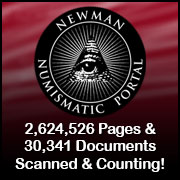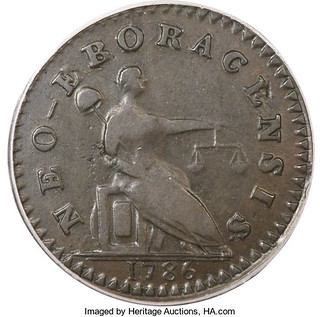
About UsThe Numismatic Bibliomania Society is a non-profit association devoted to the study and enjoyment of numismatic literature. For more information please see our web site at coinbooks.org SubscriptionsThose wishing to become new E-Sylum subscribers (or wishing to Unsubscribe) can go to the following web page link MembershipThere is a membership application available on the web site Membership Application To join, print the application and return it with your check to the address printed on the application. Print/Digital membership is $40 to addresses in the U.S., and $60 elsewhere. A digital-only membership is available for $25. For those without web access, write to: Charles Heck, Treasurer
AsylumFor Asylum mailing address changes and other membership questions, contact Chuck at this email address: treasurer@coinbooks.org SubmissionsTo submit items for publication in The E-Sylum, write to the Editor at this address: whomren@gmail.com BUY THE BOOK BEFORE THE COIN |
- WAYNE'S WORDS: THE E-SYLUM OCTOBER 9, 2019
- NUMISMATIC LITERATURE DEALERS GATHER IN LONDON
- KOLBE LIBRARY SALE HIGHLIGHTS PART2
- NEW BOOK: MONNAIES FRANçAISES, 1789-2019
- NEW BOOK: JACQUES WIENER'S REMARKABLE MEDALS
- NEW BOOK: PRINTED IN BEIRUT
- BOOK REVIEW: GIRL ON THE SILVER DOLLAR
- KOLBE & FANNING CATALOGS ON NEWMAN PORTAL
- FUTURE OF NUMISMATICS: LIPTON
- NEWMAN PORTAL SEEKS LIBRARY TECHNICAL ASSISTANT
- THE NELSON T. THORSON LIBRARY SALES
- QUERY: 1786 NEO-EBORACENESIS ELECTROTYPES
- NOTES FROM E-SYLUM READERS: OCTOBER 6, 2019
- 2019 HARRISBURG COIN SHOW PHOTOS
- VOCABULARY TERM: FERROTYPE
- EDWARD PAYSON TENNEY (1844-1912),
- HARVEY STACK'S NUMISMATIC FAMILY, PART 54
- CANADA'S EAGLE FEATHER COIN DESIGNER
- POLITICAL COUNTERMARKS IN NORTHERN IRELAND
- SEDWICK NOVEMBER 2019 SALE HIGHLIGHTS
- STEPHEN ALBUM RARE COINS AUCTION 35 RESULTS
- NUMISMATIC NUGGETS: OCTOBER 6, 2019
- ESTONIAN VIKING-ERA SILVER COIN FIND
- DETECTORISTS ACCUSED OF STEALING COIN HOARD
- S.S. NORTH CAROLINA MAY HOLD DAHLONEGA COINS
- 1813 BIRMINGHAM WORKHOUSE SIXPENCE
- GOLD TELFORD MEDAL OFFERED
- A FAMILY OF STRUCK FAKE LARGE CENTS
- AUSTRALIAN $20 HAS FEATURES FOR VISION-IMPAIRED
- PAPERBOY COLLECTING LESSONS
- WORLD'S LARGEST NOBEL PRIZE MEDAL
- FEATURED WEB PAGE: RENAISSANCE PORTRAIT MEDALS
Click here to access the complete archive
To comment or submit articles, reply to whomren@gmail.com
Content presented in The E-Sylum is not necessarily researched or independently fact-checked, and views expressed do not necessarily represent those of the Numismatic Bibliomania Society.
WAYNE'S WORDS: THE E-SYLUM OCTOBER 9, 2019
 This week we open with a gathering of numismatic literature dealers in London, highlights from the George F. Kolbe library sale, three new books, a review, and updates
from the Newman Numismatic Portal.
This week we open with a gathering of numismatic literature dealers in London, highlights from the George F. Kolbe library sale, three new books, a review, and updates
from the Newman Numismatic Portal.
Other topics this week include dealer Kevin Lipton, ANA President Nelson Thorson, the Harrisburg and PAN coin shows, ferrotypes, communion tokens, political countermarks in Northern Ireland, highlights of the upcoming Sedwick and Album sales, coin finds from the S.S. North Carolina wreck, fake Large Cents and collecting lessons from an old paperboy.
To learn more about the Coinex Coin Fair, Jacques Wiener's architectural medals, U.S. Mint Coloring Books, the 1 1/2 cent piece, Canada's Eagle Feather coin, a double-struck Wheat Cent, the Birmimgham Workhouse sixpence, the gold Telford medal, the Laughing Kookaburra and the Monkey Coin Collector, read on. Have a great week, everyone!
Wayne Homren
Editor, The E-Sylum
NUMISMATIC LITERATURE DEALERS GATHER IN LONDON
Charlie Davis writes:
I look forward each year to the annual Coinex Coin Fair in London. At the reception prior to this year's show Phil Skingley, Caroline Holmes, Douglas Saville, and I got together to note a combined 125 plus years as sellers of rare and out of print numismatic books. I have been most fortunate to be able call them colleagues and friends and hope to continue the relationship for years to come.
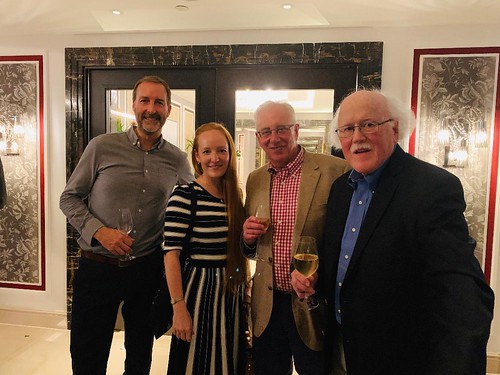
From Left: Philip Skingley, Caroline Holmes, Douglas Saville, Charles Davis
Phil Skingley of Coincraft in London is the former head of the Book Department at SPINK and Editor of Coins of England and the United Kingdom.
Caroline Holmes of the London office of Classical Numismatic Group is the former book specialist at Baldwin's.
Doug Saville also formerly headed the Book Department at SPINK and operates Douglas Saville Numismatic Books.
Charlie Davis, based in Wenham, Massachusetts, has been a dealer in numismatic literature since 1979.
Great event - I wish I could have been there. Thanks for sending this. -Editor
KOLBE LIBRARY SALE HIGHLIGHTS PART2
This press release provides more highlights from the upcoming Kolbe & Fanning sale of the George F. Kolbe library. A great opportunity for bibliophiles and researchers alike. There is some amazing, one-of-a-kind material offered here, the product of a lifetime of thoughtful collecting. -Editor
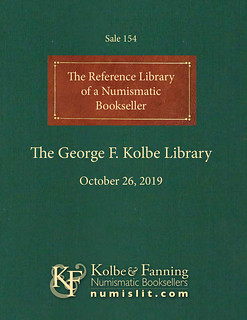 On October 26, Kolbe &
Fanning Numismatic Booksellers will be offering for sale at auction the personal library formed by founder George F. Kolbe. The live internet auction can be accessed via our
online auction platform at bid.numislit.com, and a PDF of the printed catalogue can be downloaded from the main Kolbe & Fanning website
at numislit.com. The 166-page printed catalogue mailed Thursday to active clients on our mailing list.
On October 26, Kolbe &
Fanning Numismatic Booksellers will be offering for sale at auction the personal library formed by founder George F. Kolbe. The live internet auction can be accessed via our
online auction platform at bid.numislit.com, and a PDF of the printed catalogue can be downloaded from the main Kolbe & Fanning website
at numislit.com. The 166-page printed catalogue mailed Thursday to active clients on our mailing list.
The auction of the Kolbe Library includes the works catalogued by George in his 2012 book, The Reference Library of a Numismatic Bookseller, as well as additional items acquired in the years since. It is an outstanding offering of numismatic bibliographies, reference books, catalogues, and special editions from around the world amassed over a career spanning more than fifty years.
A few selected highlights include:
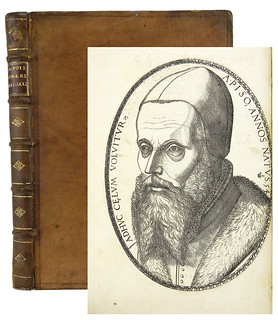
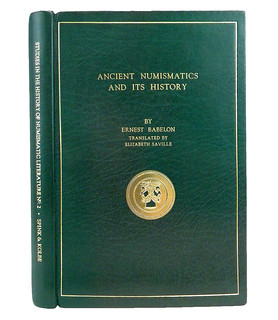
Lots 1 and 15
Lot 1: a handsome copy of Antoine Le Pois's 1579 Discours sur les medalles et graveures antiques, featuring the first numismatic bibliography
Lot 15: one of three copies bound in full morocco of the 2004 translation of Ernest Babelon's Ancient Numismatics and Its History, Including a Critical Review of the Literature
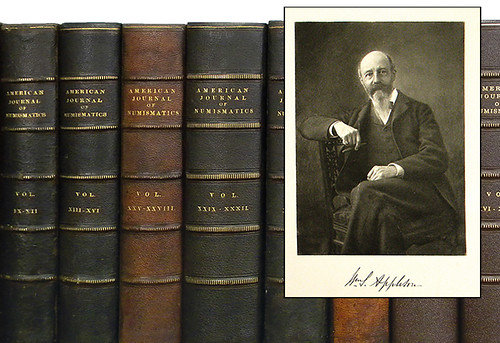
Lot 261
Lot 261: a fine complete bound set of the American Journal of Numismatics, with the first 32 volumes being from the library of William Sumner Appleton
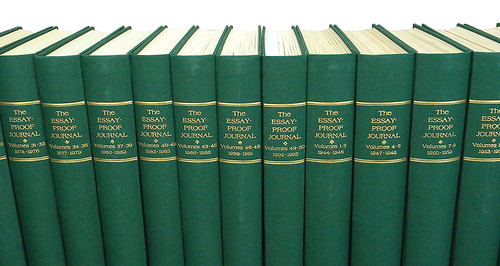
Lot 270
Lot 270: a complete bound set of The Essay-Proof Journal, an outstanding resource for information on paper money and philately
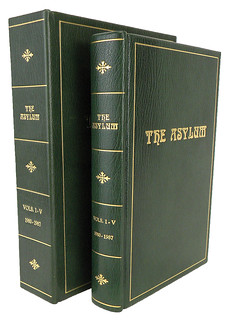
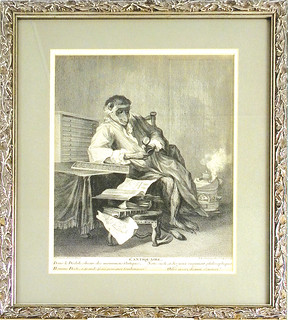
Lots 276 and 442
Lot 276: an extraordinary set of The Asylum, bound in full green morocco and housed in matching clamshell boxes
Lot 442: Pierre Louis Surugue's fine 1743 engraving of Jean-Baptiste-Siméon Chardin's The Antiquarian, or the Monkey Coin Collector
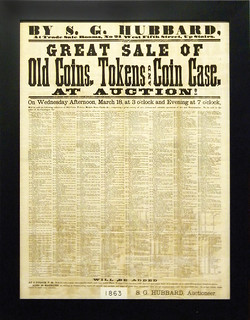
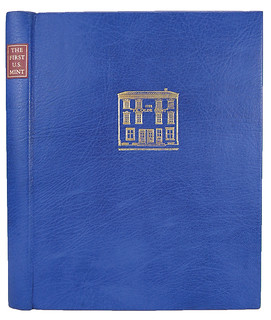
Lots 449 and 469
Lot 449: an extremely rare and visually impressive 1863 numismatic broadside printed for the first numismatic auction held in Cincinnati
Lot 469: one of four copies produced of the Authors' Edition, bound in blue full morocco, of Orosz & Augsburger's 2011 The Secret History of the First U.S. Mint
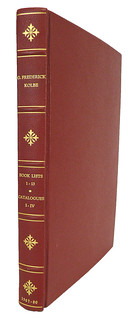
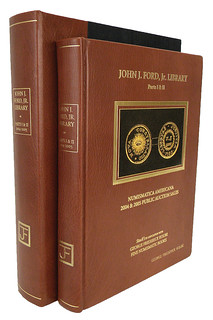
Lots 479 and 497
Lot 497: a unique full morocco combined edition copy of the Ford Library sales, presented to George Kolbe by Kater-Crafts Bookbinders, the firm commissioned to prepare the various special editions of those catalogues.
Kolbe & Fanning use Auction Mobility as our third-party online bidding platform. To register for the sale, bidders should go to bid.numislit.com and sign up. Once you have set up an account, you may browse lots, place advance bids, or participate in the live sale on your computer, tablet, or phone. Please note that as this is a third-party site, your login information for the main K&F site will not work for the auction site: you need to establish a separate account. Those wishing to participate on their devices can download the Kolbe & Fanning app through the Apple or Google Play Store.
Bids also may be placed via post, email, fax or phone. Bids placed via post, email, fax or phone must be received by October 25, the day before the sale, in order for them to be processed. Advance absentee bids may also be placed at any time online at bid.numislit.com; live internet bidding will be available during the sale itself through the same platform.
Kolbe & Fanning Numismatic Booksellers LLC is a licensed and bonded auction firm in the State of Ohio. For more information, please see the Kolbe & Fanning website at numislit.com or email David Fanning at df@numislit.com. To register for the sale, go to bid.numislit.com. To sign up to receive Kolbe & Fanning's occasional email announcements, please visit numislit.com or email Maria Fanning at maria@numislit.com. We look forward to your participation.
To read the earlier E-Sylum article, see:
KOLBE & FANNING SALE 154 ANNOUNCED (https://www.coinbooks.org/v22/esylum_v22n39a02.html)

NEW BOOK: MONNAIES FRANçAISES, 1789-2019
Collectors of U.S. coins have the Red Book. Collectors of French coins have the Rouge Book. Here is the announcement for the latest edition of the Gadoury book on French coins. -Editor
Gadoury releases 2020 edition of French Standard Reference, Monnaies Françaises, 1789-2019 (“Le Rouge”)
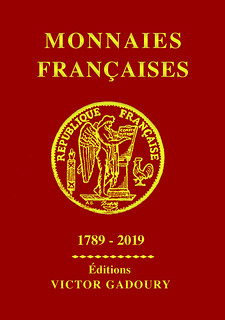 Monnaies Françaises has
been the bible on the coins of modern France since it was first published in 1973. It is now authored by Francesco Pastrone and published by Editions Victor Gadoury of Monaco. It
is called "Le Rouge" (The Red) in French. The 24 th edition, covering the years 1789 to 2019, with all illustrations in color, and a number of new features is now being
printed and will be available in North America by the end of November. Making its debut in this edition is a chapter for Napoleon I featuring the avidly collected essais,
piéforts, and proofs or flans bruni struck during his reign. Also new is expanded coverage of all the silver and copper coins of Napoleon in Italy, the latest coins of the Monnaie
de Paris, and a new issue from Monaco in the widened coverage of that country. In addition, there are many improved high quality illustrations, many of them showing close-up
details.
Monnaies Françaises has
been the bible on the coins of modern France since it was first published in 1973. It is now authored by Francesco Pastrone and published by Editions Victor Gadoury of Monaco. It
is called "Le Rouge" (The Red) in French. The 24 th edition, covering the years 1789 to 2019, with all illustrations in color, and a number of new features is now being
printed and will be available in North America by the end of November. Making its debut in this edition is a chapter for Napoleon I featuring the avidly collected essais,
piéforts, and proofs or flans bruni struck during his reign. Also new is expanded coverage of all the silver and copper coins of Napoleon in Italy, the latest coins of the Monnaie
de Paris, and a new issue from Monaco in the widened coverage of that country. In addition, there are many improved high quality illustrations, many of them showing close-up
details.
At 608 pages, Monnaies Françaises is 18 pages larger than its last edition. It has information on all French coins minted since the revolution of 1789 through the current Fifth Republic in chronological order by denomination (smallest to largest), including both the circulation and collector issues of France's modern euro coins through 2019. Also given are: metal, fineness, weight, diameter, edge, engraver's name and privy marks. Mintage figures are provided by date and mint mark for each denomination, along with the current values in euros in up to five grades. Included are obsidional coinage issued for the sieges of Mainz and Antwerp, and special sections on commemorative coins, coins of Monaco, coins of Corsica (1736, 1762-68), coins of Saarland (1954-55), the coins of the Kingdom of Westphalia, and an illustrated guide of all privy marks.
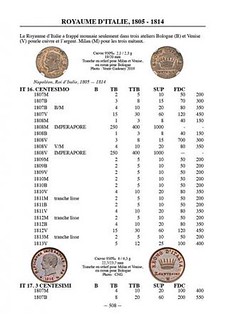
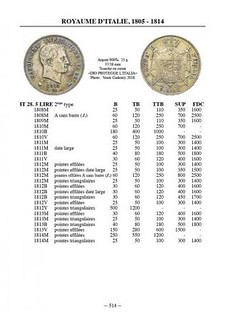
The book is $44.95 and can be ordered from the Coin & Currency Institute, P.O. Box 399, Williston, Vermont 05495. $5.75 should be added to each order for shipping and handling in the U.S.A.. Major credit cards are accepted. Call toll-free 1-800-421-1866. Fax (802) 536-4787. E-mail: mail@coin-currency.com. Order online and see a few sample pages at www.coin-currency.com .
NEW BOOK: JACQUES WIENER'S REMARKABLE MEDALS
A new book published by the American Numismatic Society is available for pre-order and will ship in October. -Editor
Jacques Wiener's Most Remarkable Edifices of Europe: The Man, Monuments, and Medals
Michael Ross
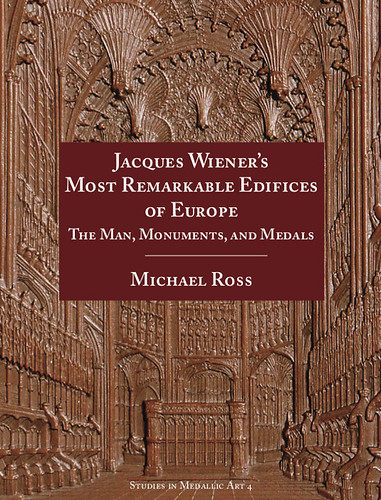 The nineteenth century medal series The Greatest Edifices of Europe by Belgian engraver-medalist
Jacques Wiener is examined in detail. The work begins by providing a biographical background for Wiener, integrating two primary, existing sources. The overall medal series is
then addressed starting with its inception as defined in Wiener's original 1854 prospectus through its quietly incomplete conclusion.
The nineteenth century medal series The Greatest Edifices of Europe by Belgian engraver-medalist
Jacques Wiener is examined in detail. The work begins by providing a biographical background for Wiener, integrating two primary, existing sources. The overall medal series is
then addressed starting with its inception as defined in Wiener's original 1854 prospectus through its quietly incomplete conclusion.
The scope of the series, its range of issue dates, and elements and characteristics of its production are presented. For each edifice commemorated, the associated medals, including new and unpublished varieties, are presented, legends translated, die characteristics examined, contemporary supporting documentation cited, issue dates revised, and source images used by the artist are identified in limited cases. Where applicable, instances of divergence between the state of the actual monument and Wiener's renderings are noted as well. The intent of the work is to provide a greater understanding of the medal series through a contextual approach.
ISBN: 9780897223591
Published by: American Numismatic Society
Series: Studies in Medallic Art
Volume: 4
Year of Publication: 2020
Language: English
Hardback
350p,
H11 x W8.5,
$100.00
Status: Not Yet Published - Available for pre-order
These magnificent medals are widely collected and this book will be a most welcome reference. -Editor
For more information, or to order, see:
Jacques Wiener's Most Remarkable Edifices of Europe: The Man, Monuments, and
Medals [Hardback] (https://www.oxbowbooks.com/dbbc/jacques-wiener-s-most-remarkable-edifices-of-europe.html)
NEW BOOK: PRINTED IN BEIRUT
Gerry Tebben writes:
Thanks. I couldn't locate the review online, but found this at Publisher's Weekly. The book is available on Amazon. It was published in 2018. -Editor
Printed in Beirut
Jabbour Douaihy, trans. from Arabic by Paula Haydar. Interlink, $15 trade paper (224p) ISBN 978-1-62371-990-6
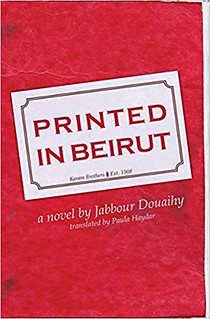 Aspiring author Farid Abu Shaar,
the hero of this entertainingly jaundiced look at Beirut's publishing and printing industry from Lebanese novelist Douaihy (Chased Away), undergoes a series of swift,
comical, and brutal face-to-face rejections of his handwritten manuscript, The Book to Come, which is contained in a red notebook and about whose contents the reader learns
nothing. At last he calls on Karam Brothers Press, whose owner, Abdallah Karam, also rejects The Book to Come but offers Farid a job as a copy editor, which he accepts.
Aspiring author Farid Abu Shaar,
the hero of this entertainingly jaundiced look at Beirut's publishing and printing industry from Lebanese novelist Douaihy (Chased Away), undergoes a series of swift,
comical, and brutal face-to-face rejections of his handwritten manuscript, The Book to Come, which is contained in a red notebook and about whose contents the reader learns
nothing. At last he calls on Karam Brothers Press, whose owner, Abdallah Karam, also rejects The Book to Come but offers Farid a job as a copy editor, which he accepts.
Abdallah's beautiful and aloof wife, Persephone Melki, becomes fascinated by Farid and the notebook he always keeps with him. When Farid just once forgets his notebook, Persephone finds it and has a copy of it printed on expensive paper. That precious copy is left on Farid's desk with no explanation, and Farid later determines that the paper is the same used to counterfeit €20 notes, and he's swept into a police investigation. Douaihy illuminates Lebanon's tumultuous recent history in brief but telling passages using the fates of Persephone, Farid, and Farid's book as his compass. Bemused readers will be both enlightened and charmed.
To read the complete article, see:
Printed in Beirut (https://www.publishersweekly.com/978-1-62371-990-6)
For a longer article about the book, see:
Printed in Beirut (http://www.rayaagency.org/clients/douaihy-jabbour/printed-in-beirut/)
For more information, or to order, see:
Printed in Beirut (https://www.amazon.com/Printed-Beirut-Jabbour-Douaihy/dp/1623719909)

BOOK REVIEW: GIRL ON THE SILVER DOLLAR
On October 1, 2019 Lou Golino published a great CoinWeek article reviewing Roger Burdette's new book, Girl on the Silver Dollar. Here's an excerpt - see the complete article online for mure more. -Editor
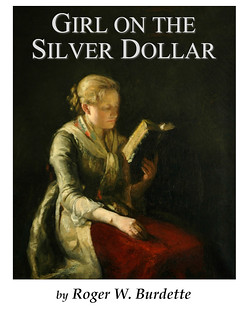 Ask most collectors of
the Morgan silver dollar issued from 1878 to 1921 who the model was for the image of Liberty that appears on the coin's obverse, and they will likely say it is Anna Willes
Williams. Born in 1857, Williams was a Philadelphia schoolteacher at the time, who went by the nickname Nannie.
Ask most collectors of
the Morgan silver dollar issued from 1878 to 1921 who the model was for the image of Liberty that appears on the coin's obverse, and they will likely say it is Anna Willes
Williams. Born in 1857, Williams was a Philadelphia schoolteacher at the time, who went by the nickname Nannie.
Burdette says the matter of Williams' role on the Morgan coin will probably never be fully resolved but lays out a compelling case based on extensive research into her, famous United States Mint designer and engraver George T. Morgan, and the artist Thomas Eakins–for whom Williams also modeled and who introduced her to Morgan–that is based on U.S. Mint and Treasury documents from the National Archives and press accounts and numismatic articles of the era.
He also explains that she did model a number of times for Morgan in 1876 while he was working on the silver dollar obverse but that her actual features and youthful appearance are present not in that design but instead on the famous 1879 School Girl pattern and a half eagle pattern. For example, the chin on the Morgan obverse resembled that of Morgan's wife, who arrived from England in 1877, rather than that of Ms. Williams.
Moreover, Morgan, who came to the U.S. from England in 1876 after the Royal Mint's deputy master recommended him to U.S. Mint Director Henry Linderman, had already begun work on a Liberty head silver dollar obverse before arriving in America. He was hired specifically to create the designs for a new silver dollar due to widespread dissatisfaction with the coinage of Charles Barber. Director Linderman wanted a new design for a silver dollar with a “classical head of Liberty” (i.e., one based on Greco-Roman motifs) that might be used on all silver coins except the Trade dollar (Burdette, 10).
Based on his training that emphasized “copying classical models with a strong emphasis on French interpretation” (Burdette, 12), all of Morgan's Liberty designs featured “the Grecian nose and forehead which was considered ‘classical beauty' of the time” (Burdette, 30). But we also know that after Morgan arrived in the U.S., he wanted to give his design a more distinctly American look that reflected the beauty of young American women he saw in Philadelphia.
Burdette's book — a model for the kind of original numismatic research that can change our understanding of important facets of the hobby — is essential reading for Morgan dollar enthusiasts and anyone interested in the history of American coinage. It is high time that a numismatic researcher has finally uncovered what appears to be the real story about the Morgan dollar design that reveals a lot about American social mores and artistic standards of the late 19th century.
To read the complete article, see:
The Coin Analyst: Girl on the
Silver Dollar and the Merging of Greco-Roman and American Visions of Liberty
(https://coinweek.com/us-coins/the-coin-analyst-girl-on-the-silver-dollar-and-the-merging-of-greco-roman-and-american-visions-of-liberty/)
To read the earlier E-Sylum article, see:
NEW BOOK: GIRL ON THE SILVER DOLLAR (https://www.coinbooks.org/v22/esylum_v22n38a02.html)
KOLBE & FANNING CATALOGS ON NEWMAN PORTAL
The latest additions to the Newman Numismatic Portal are the auction catalogs of numismatic booksellers Kolbe & Fanning. Project Coordinator Len Augsburger provided the following report. -Editor
Kolbe & Fanning Auction Sale Catalogs on Newman Portal
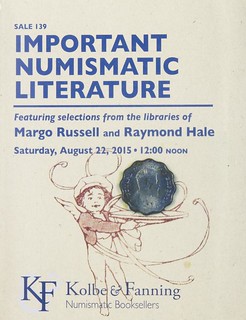 As previously announced by Kolbe
& Fanning, in conjunction with the sale of the George F. Kolbe library on October 26, the firm is making their historic auction sale catalogs available on Newman Portal. The
majority of these have now been posted on Newman Portal, with the remainder coming soon. After a modest beginning in 1976, the firm was running full tilt by its ninth sale in
1981, which featured consignments from Armand Champa, the estate of Kenneth Lee, and the Essex Institute. Harry W. Bass, Jr. John W. Adams, Jack Collins and many others competed
to drive prices up to record levels, and the pursuit of collecting numismatic literature fully came into its own. The formation of the Numismatic Bibliomania Society complemented
the commercial activity, and since then Kolbe & Fanning have handled many important libraries, including those of Adams, Bass, Stack's, Ford, and others.
As previously announced by Kolbe
& Fanning, in conjunction with the sale of the George F. Kolbe library on October 26, the firm is making their historic auction sale catalogs available on Newman Portal. The
majority of these have now been posted on Newman Portal, with the remainder coming soon. After a modest beginning in 1976, the firm was running full tilt by its ninth sale in
1981, which featured consignments from Armand Champa, the estate of Kenneth Lee, and the Essex Institute. Harry W. Bass, Jr. John W. Adams, Jack Collins and many others competed
to drive prices up to record levels, and the pursuit of collecting numismatic literature fully came into its own. The formation of the Numismatic Bibliomania Society complemented
the commercial activity, and since then Kolbe & Fanning have handled many important libraries, including those of Adams, Bass, Stack's, Ford, and others.
This catalog set as a whole describes over 100,000 items of numismatic literature, and, while there is naturally some lot duplication, it is clear that this represents a monumental effort, comparable in scope to the ANS library catalog. This copious record has, and will continue, to serve as a premier bibliographic resource for numismatic literature, with detailed and authoritative descriptions of nearly every important work in the field.
Kolbe and Fanning have catalogued even the most esoteric items with an eye toward putting them into greater context and giving the reader a well-formed idea of their place in the numismatic universe, often more substantive than might first appear. Some works are by definition more mundane than others, but all are given careful consideration in these thoughtfully prepared catalogs.
This will be an amazingly useful resource for numismatic bibliophiles and researchers! -Editor
Link to Kolbe & Fanning auction sale catalogs on Newman Portal:
https://nnp.wustl.edu/library/auctioncompanydetail/513111
Link to the George F. Kolbe library sale on October 26, 2019:
https://bid.numislit.com/auctions/1-2AAE6K/the-george-f-kolbe-library-sale-154
FUTURE OF NUMISMATICS: LIPTON
These are selections from the David Lisot Video Library that feature news and personalities from the world of coin collecting. David has been attending coin conventions since
1972 and began videotaping in 1985. The Newman Numismatic Portal now lists all David's videos on their website at:
https://nnp.wustl.edu/library/multimediadetail/522852
Here's one from the ANA Future of Numismatics Symposium. -Editor
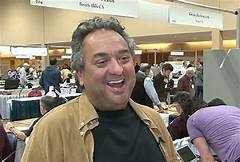 Future of Numismatics Symposium: Kevin Lipton
Future of Numismatics Symposium: Kevin Lipton
An excerpt of the video is available for viewing on the Coin Television YouTube Channel at:
https://youtu.be/725PiHeEYa0
This video is a highlight from Future of Numismatics Symposium: What the Future May Hold
Donn Pearlman, Moderator, David Lisot, Video Producer, CoinTelevision.com.
At the 2019 World's Fair of Money the American Numismatic Association asked some of the coin industry's most influential leaders about what they believe is in store for the future of the hobby. Hear these titans of numismatics share what they believe the future holds.
NEWMAN PORTAL SEEKS LIBRARY TECHNICAL ASSISTANT
Wanna be immersed in numismatic literature? The Newman Numismatic Portal has a job opening. Project Coordinator Len Augsburger passed this along. -Editor
Newman Numismatic Portal Seeks Library Technical Assistant
Newman Portal is seeking a full-time library technical assistant to help continue the growth of this online resource. The position summary is as follows:
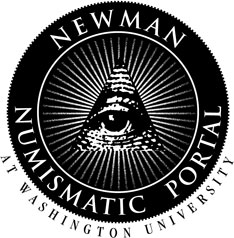 "Responsible for digital imaging
activities for the Newman Numismatic Portal project operating in the Preservation & Digitization department of Special Collections (at Washington University in St. Louis).
Manages scanning workflow, including working with the Project Coordinator to set priorities and manage shipping and delivery of rare materials. Oversees student workers employed
by the Newman project including hiring, training, scheduling and quality control of work. Manages ingestion of Newman related materials into the Internet Archive. Regularly
reports progress of scanning operations to the Digitization Manager and Project Coordinator (Len Augsburger). The Digitization Library Technical Assistant is a grant funded,
time-limited position based at Washington University in St. Louis."
"Responsible for digital imaging
activities for the Newman Numismatic Portal project operating in the Preservation & Digitization department of Special Collections (at Washington University in St. Louis).
Manages scanning workflow, including working with the Project Coordinator to set priorities and manage shipping and delivery of rare materials. Oversees student workers employed
by the Newman project including hiring, training, scheduling and quality control of work. Manages ingestion of Newman related materials into the Internet Archive. Regularly
reports progress of scanning operations to the Digitization Manager and Project Coordinator (Len Augsburger). The Digitization Library Technical Assistant is a grant funded,
time-limited position based at Washington University in St. Louis."
Link to the complete Washington University job posting:
Job Title Library Technical Assistant, Digitization (Time-Limited) - University Libraries - 45544 (https://jobs.wustl.edu/psc/APPLHRMS/EMPLOYEE/HRMS/c/HRS_HRAM
.HRS_APP_SCHJOB.GBL?Page=HRS_APP_JBPST&REL_ACTION=Yes&SiteId=1&HRS_JO_PST_TYPE
=E&HRS_JOB_OPENING_ID=45544&HRS_JO_PST_SEQ=1)

THE NELSON T. THORSON LIBRARY SALES
David Fanning writes:
I was interested in reading John Lupia's biographical entry on Nelson Thore Thorson in last week's E-Sylum. John's contributions to the E-Sylum are always worth reading, and he does a great job at digging out details others have missed. This one caught my eye because I had just recently catalogued George Kolbe's set of the three auction catalogues issued by the Culkin Stamp Company offering Thorson's numismatic library. I had not been familiar with these, but they are quite interesting and rarely encountered.
Thanks - I had been unaware of those sales as well. I own Thorson's set of the Coin Collectors Journal, which must have come through these sales. Here is the full lot description. -Editor
 DESCRIPTION
DESCRIPTION
Culkin Stamp Co. NELSON T. THORSON LIBRARY AUCTION. Omaha, April 15, 1959. Duplicated typescript leaves [36 by 22 cm] stapled at top left corner. 37, (1) pages; 273 lots. Prices
realized. Very good or better. [with] Culkin Stamp Company. SECOND UNRESERVED AUCTION OF NUMISMATIC LIBRARY ESTATE OF NELSON T. THORSON. Omaha, May 4, 1964. 8vo, self-covered, as
issued. (16) pages; 821 lots. Near fine. [with] Culkin Stamp Company. THIRD & FINAL UNRESERVED AUCTION OF NUMISMATIC LIBRARY ESTATE OF NELSON T. THORSON. Omaha, May 4, 1965.
8vo, self-covered, as issued. (2), 25, (1) pages; 199 lots. Prices realized. Very good. Rather remarkable if little-known sales of antiquarian titles and classic works on ancient,
medieval and modern numismatic topics, many in folio or quarto format. A note at the head of the final prices realized list states: “Lots not listed were not sold/donated to
Philamatic Center/Boys Town Nebr.” Kolbe 960, 961 and 962.
To read the complete lot description, see:
The Nelson Thorson Library
(https://bid.numislit.com/lots/view/1-2AAI5Y/the-nelson-thorson-library)
To read the earlier E-Sylum article, see:
NELSON THORE THORSON (1881-1951) (https://www.coinbooks.org/v22/esylum_v22n39a16.html)
QUERY: 1786 NEO-EBORACENESIS ELECTROTYPES
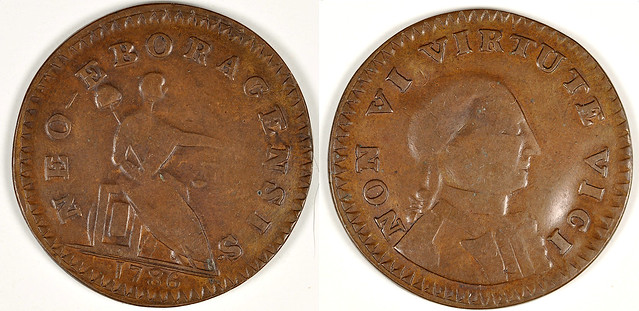
Craig Sholley writes:
"At the recent Gettysburg show, I had the good fortune to come across a nice electrotype of the very rare 1786 Neo-Eboracenesis copper. While I've seen genuine pieces, I have never seen an electro, so I quickly bought it.
"Arriving home, I checked the fixed price lists of Charles Enders, Jr. and Scott Stamp and Coin. Both offered electrotypes of the "more common" 1787 Nova Eborac, but neither listed the Neo-Eboracensis. Over the next few days, I searched various auction websites and could not find one sold in the last 20 years.
"I then searched the 19th and early 20th century auction catalogs on the Newman Numismatic Portal and found only two listings. The first was in a July 1865 McGilvray sale, where it was noted as a "copy," so probably an electro. The other was in a March 1885 Haseltine sale, cataloged as an electro.
"Do E-Sylum readers know of any other electrotypes of this piece?"
If anyone can help with a question as obscure as this, it's an E-Sylum reader. Thoughts, anyone? I added an image of a genuine piece from Heritage Auctions. -Editor
To read the complete lot description, see: 1786 COPPER New York Copper, NON VI VIRTUTE VICI, Small Head XF40 PCGS. CAC. Baker-13, W-5730, R.6.... (https://coins.ha.com/itm/colonials/1786-copper-new-york-copper-non-vi-virtute-vici-small-head-xf40-pcgs-cac-baker-13-w-5730-r6/a/1177-3035.s)
NOTES FROM E-SYLUM READERS: OCTOBER 6, 2019
More on Ingle System Token Dispensers
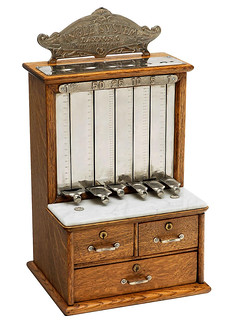 Regarding Ingle System token
dispensers, Dave Schenkman writes:
Regarding Ingle System token
dispensers, Dave Schenkman writes:
Those things are really neat. There are two types, both of which are pictured in “The System Scrip Makers of Western Ohio,” a TAMS Journal supplement Eric Schena and I co-authored in 2016. In the 1960s I found one identical to the one at auction, with about a hundred of the tokens still in the drawers.
Nice find. What a great showpiece for a token collection! -Editor
To read the earlier E-Sylum article, see:
NUMISMATIC NUGGETS: SEPTEMBER 29, 2019 : Ingle System Token Dispenser Register
(https://www.coinbooks.org/v22/esylum_v22n39a18.html)
Boy Scout Camp $2 Bill Stunt
George Cuhaj writes:
Since 1927 the Greater New York Councils of the Boy Scouts has operated Ten Mile River Scout Camps on 12,000 acres in Sullivan County, near Monticello and Narrowsburg NY (with some Delaware River frontage).
Every once in a while the residents of the county scheme to tax the property. So in the summer of 1976 for two or three weeks the staff members were paid half by the normal check and half by $2 dollar bills.
Once the local communities were flooded with the twos, folks realized how much of an additional financial impact the scouts brought to the county and beyond.
The tax talk subsided.
Thanks. Try THAT with your electronic payments. It's not so easy to make the invisible visible. The standout appearance of $2 bills is hard to miss. -Editor
To read the earlier E-Sylum article, see:
$2 Bills As a Statement of Economic Power : $2 Bills As a Statement of Economic Power
(https://www.coinbooks.org/v22/esylum_v22n39a14.html)
U.S. Mint Coloring Books
Malcolm Johnson of the Pennsylvania Association of Numismatists writes:
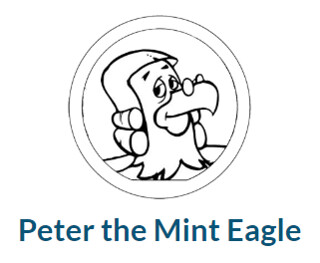 I liked your idea of producing a
coin coloring book for adults. You're probably already aware that the U.S. Mint publishes a coloring book for YNs. I requested a PDF Copy and they sent an entire box with 100
copies once I told them it was for our PAN KidZone. Not really difficult enough to challenge adults, but certainly great fun for the young ones. I already have crayons and colored
pencils for the KidZone visitors on 19 October. I think those coloring books are going to be a big hit along with our “Color Ben” contest.
I liked your idea of producing a
coin coloring book for adults. You're probably already aware that the U.S. Mint publishes a coloring book for YNs. I requested a PDF Copy and they sent an entire box with 100
copies once I told them it was for our PAN KidZone. Not really difficult enough to challenge adults, but certainly great fun for the young ones. I already have crayons and colored
pencils for the KidZone visitors on 19 October. I think those coloring books are going to be a big hit along with our “Color Ben” contest.
The PAN Shows are great for adults as well as kids. See the link below for more information on their upcoming fall show October 17-19. -Editor
To read the earlier E-Sylum article, see:
NEW BOOK: COINS OF ENGLAND COLOURING BOOK (https://www.coinbooks.org/v22/esylum_v22n39a08.html)
For more information on the U.S. Mint's coloring pages, see:
Coloring Pages (https://www.usmint.gov/learn/kids/games/coloring-pages)
For more information on PAN, see:
https://pancoins.org
Query: Floating Trophy Medal
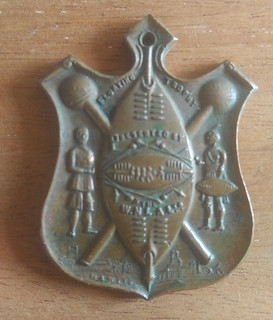 David Pickup writes:
David Pickup writes:
I am sending a photo of a copper medallion I bought yesterday. I hope someone can shed some light on this. It is uniface made of copper and inscribed:
FLOATING TROPHY
PRESENTED BY
THE
W N L A Ltd
The maker seems to be M AW or M & W Ltd
Any ideas?
Interesting piece. I've never seen anything like it. Thoughts, readers? -Editor
Cartoon: Monetize the Mint
Len Augsburger passed along this Harry Bliss cartoon, first published October 2, 2019. Thanks. -Editor
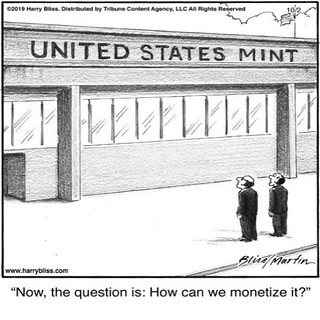
For more Harry Bliss cartoons. see:
http://www.harrybliss.com/store/

2019 HARRISBURG COIN SHOW PHOTOS
Rick Lank of Hagerstown, MD writes: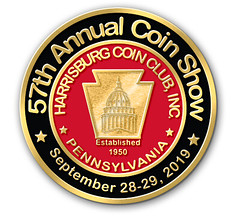 I just came back from the Harrisburg
coin show and looks like we are headed back to PAN this month! Pat McBride from PAN was at show as the famous founding father, Ben Franklin, and he fits into the garb and the part
perfectly. Very convincing!
I just came back from the Harrisburg
coin show and looks like we are headed back to PAN this month! Pat McBride from PAN was at show as the famous founding father, Ben Franklin, and he fits into the garb and the part
perfectly. Very convincing!
Also at the Show was a metal detectorist (and detector salesman) by the name of "A. Blessing" - nice. Anyway, his finds were legend and he had many a colonial copper and some "chopped" coins -- including a US silver three-center that was cut in half.... so somebody made 1 1/2 cents in change. I had never seen that before......
Rick kindly provided these photos. Thanks! -Editor
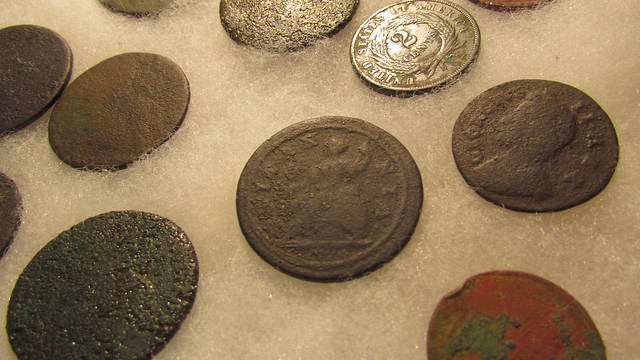
Coin Finds
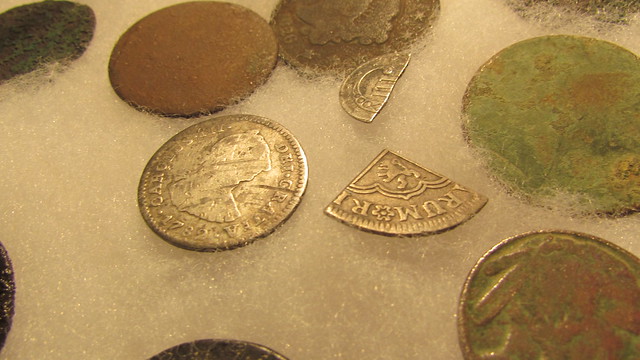
More Coin Finds
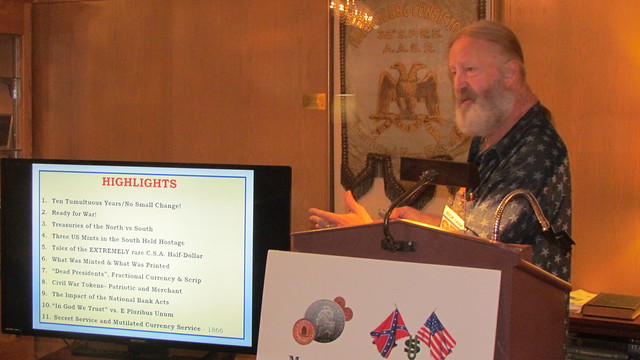
Rick Lank
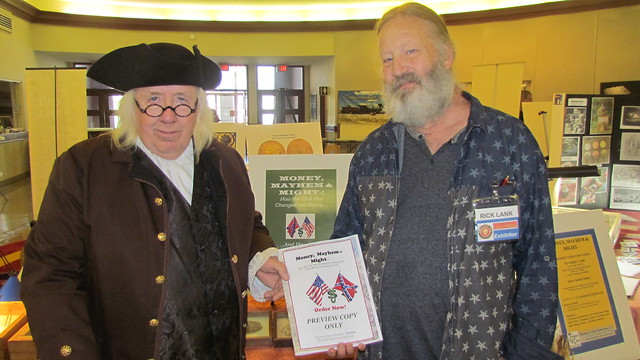
"Ben Franklin" and Rick Lank
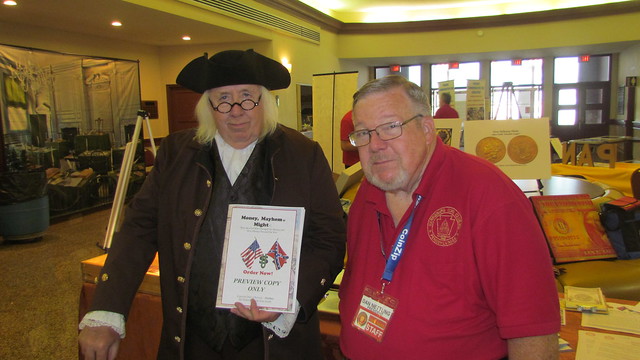
"Ben Franklin" and Harrisburg Coin Club President Dan Nettling
For more information on the clubs, see:
https://harrisburgcoinclub.com/
https://pancoins.org
Rick and his wife Becky are writing a book on Civil War numismatics - see the links below for more information. -Editor
To order Money, Mayhem & Might, see:
Money, Mayhem & Might (https://money-mayhem-might.us/)
To read the earlier E-Sylum article, see:
NEW BOOK: MONEY, MAYHEM AND MIGHT (https://www.coinbooks.org/v22/esylum_v22n34a06.html)
VOCABULARY TERM: FERROTYPE
Dick Johnson submitted this entry from his Encyclopedia of Coin and Medal Terminology. Thanks. I added an image of a beardless 1860 Abraham Lincoln Hamlin Small Size Ferrotype badge from the site of Lori Ferber. -Editor
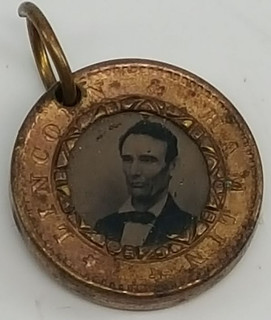 Ferrotype. An
early photograph contained in a metal frame, always diestruck. The "iron type" photograph was one of several early photographic processes. Where ferrotype gets its name
was a photo image on very thin sheet of coated iron, a process called Japanning, but was more popularly called tintype. These photo images became
widely used for campaign items, particularly for U.S. presidential candidates. Tiny photos were inset in metal frames most often made into lapel or larger pins for wearing. The
diestruck frames, made of white metal, or more commonly of brass, were designed with decorations, occasionally with lettering. All ferrotypes are fragile and the photo images fade
when exposed to strong light. Infrequently two photos – as presidential candidate on one side, vice president on the other – were made into a two-sided ferrotype.
Ferrotype. An
early photograph contained in a metal frame, always diestruck. The "iron type" photograph was one of several early photographic processes. Where ferrotype gets its name
was a photo image on very thin sheet of coated iron, a process called Japanning, but was more popularly called tintype. These photo images became
widely used for campaign items, particularly for U.S. presidential candidates. Tiny photos were inset in metal frames most often made into lapel or larger pins for wearing. The
diestruck frames, made of white metal, or more commonly of brass, were designed with decorations, occasionally with lettering. All ferrotypes are fragile and the photo images fade
when exposed to strong light. Infrequently two photos – as presidential candidate on one side, vice president on the other – were made into a two-sided ferrotype.
The use of ferrotypes grew from the many diestruck medals made in the 19th century for presidential elections. It was a way of informing an electorate of what the candidate looked like and occasionally bore a very brief campaign slogan (in a time when communication was not that rapid and illustrations of candidates were nearly nonexistent).
Despite the many steps in their manufacture, ferrotypes could be manufactured at a lower cost than solid diestruck items. Even though ferrotypes somewhat replaced earlier medallic forms, they, in turn, were completely replaced by the later inventions of the lithographed and celluloid pins.
History of the ferrotype. The combination of a photo inset in a frame was a unique development in the Connecticut Valley of New England whi ch had a vibrant metalworking industry and early embraced photography. In 1856 D.F. Malby of Waterbury invented malainotypy, the process of Japanning or placing a photo image on a coated sheet of highly polished black enameled metal; the photo image appeared as shades of gray in contrast to the black enamel. Earlier photographic processes had been used to illustrate candidates, including daguerreotype (first used in the presidential campaign of 1848) and ambrotype (1854).
Ferrotypes were widely in use in the 1860 elections when Abraham Lincoln ran against three opposing candidates including Stephen Douglas. Three different Lincoln images were incorporated in more than sixty different kinds of ferrotype frames (Lincoln's photos are dated by the absence, or presence and the length of his beard).
The ease of trimming the thin sheet metal for the frames led from the early circular or oval form to unusual shapes often made into larger items for wearing, called shell badges. After diestruck and trimmed, the piece was pierced. The photo was cut out from a sheet with many images and inserted within the frame then crimped closed. Occasionally a ferrotype shell badge was hung from a header – itself a shell and often a spread-wing eagle – to form a multiple-part badge. The ribbon used to connect the two elements was commonly an American flag or a red-white-blue ribbon. Ferrotypes were last used in the 1888 presidential campaign. Celluloid buttons were developed and completely replaced them in the next presidential election, in 1892.
Ferrotype Terms
Ambrotype – photo image by use of collodian.
Daguerreotype – earliest form of photograph.
Donut – the circular frame is highly domed.
Flakes, Flaking – tiny areas of photo image removed by wear.
Japanned – photo image on enameled sheet iron.
Oval – photo image showing in oval shape.
Shell badge – photo image in frame of unusual shape, some of several parts connected with a cloth ribbon.
Tintype – photo image on thin sheet iron (it contains no tin).
References:
O18 {1959} DeWitt, p 638-639, footnote from page 196.
Looking for the meaning of a numismatic word, or the description of a term? Try the Newman Numismatic Portal's Numismatic Dictionary at: https://nnp.wustl.edu/library/dictionary
Or if you would like a printed copy of the complete Encyclopedia, it is available. There are 1,854 terms, on 678 pages, in The Encyclopedia of Coin and Medal Technology. Even running two a week would require more than 19 years to publish them all. If you would like an advance draft of this vital reference work it may be obtained from the author for your check of $50 sent postpaid. Dick Johnson, 139 Thompson Drive, Torrington, CT 06790.
EDWARD PAYSON TENNEY (1844-1912),
Edward Payson Tenney (1844-1912), was born on September 8, 1844, in Boston, Massachusetts, son of John Haskall Tenney (1808-1882), a wool merchant, and Caroline Appleton Tenney (1814-1844). His mother died a few weeks after giving birth to Edward. She was 30 years old. His father remarried to Elizabeth "Betsy". He grew up in Chelsea, Suffolk County, Massachusetts.
Edward P. Tenney like his father before him was a woolen goods merchant. He was a collector of broad interests including coins, tokens, gems, and a variety of curiosities.
In 1867, he married Sarah Frances Badger (1843-), at Boston. They had three children Carrie (1870-1951), Marian Louise Tenney (1874-1871), and Edward Frost Tenney ().
 In 1880, he lived in Linden, New Jersey.
In 1880, he lived in Linden, New Jersey.
In April 1910 he was ANA Member No. 1370.
He died on July 16, 1912, 54 days short of his 68th birthday at Roselle, New Jersey.
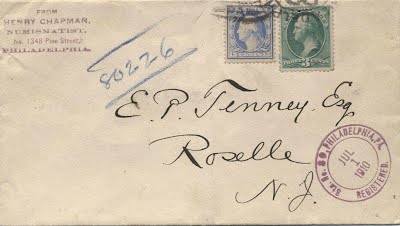
Tenney correspondence with the Chapman Brothers, registered mail postmarked Philadelphia, Pennsylvania, July 1, 1910. Chapman franked the envelope with a nearly 40 year old obsolete 3c green Washington postage stamp, and a scarce Scott #340
Does anyone have more information on Tenney? He was clearly serious about collecting communion tokens. A woman named Mary McWhorter Tenney authored a 195-page book in 1936 titled Communion Tokens, Their Origin, History and Use, but I have no idea if she was related to him. A copy of the book was sold as lot 750 in the August 15, 1971 Katen sale of the George Fuld library. The Carnegie Library of Pittsburgh holds a copy among the numismatic literature references in the Wadsworth Room (references found via the Newman Numismatic Portal). -Editor
To read the complete article, see:
TENNEY, EDWARD PAYSON
(https://sites.google.com/a/numismaticmall.com/www/numismaticmall-com/tenney-edward-payson)
The entire inventory of the Lupia Numismatic Library is for sale. Individual items will be available before the remaining archives are broken up into parcels sold at philatelic auctions in the U. S. and Hong Kong. Check NumismaticMall.com frequently as dozens of new items with estimates will be posted daily until everything is sold.
All inquiries will be given prompt and courteous attention. Write to: john@numismaticmall.com .

HARVEY STACK'S NUMISMATIC FAMILY, PART 54
The latest article in Harvey Stack's blog series focuses on inflation, gold and silver fever, and hobby expansion of the 1970s. -Editor
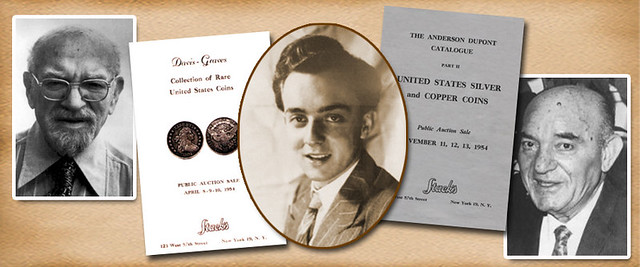
As the 1960s came to a close, there was a surge in interest in numismatics, with new collectors and the return of many who had collected earlier. Inflation became an economic worry and U.S. currency was losing its value on world markets. People read the signs, and started to search for new ways to retain capital and even increase their holdings.
Silver coins were popular, especially finding and selling coinage prior to 1964 at a profit. Gold has always been sought as a haven from ancient days until the present, and as we entered the 1970s it was being looked to as a place to put money to cope with inflation. Gold and silver, historical places to store wealth, came to the fore once more.
During the 1970-71 period, as inflation increase to over 4% per year, people started to invest more in precious metals than they had previously. Since the Gold Act of 1933-1934 limited ownership of gold by Americans to numismatic items, many chose to buy collector gold coins of United States, rather than bars or coins issued by foreign countries such as South Africa,(Krugerrand), Canada (Maple leaf) Mexico (50 Peso) and Austria (100 Coronas, 4 and 1 Ducats).
Many gravitated to the United States $20 double eagle as it had a lower premium over gold value than the other denominations of U.S. gold coins. It should be noted that years ago before restrictions developed on gold ownership in the United States, many double eagles were stored in foreign banks (where they had arrived as payments for U.S. debts). Sometimes these would be offered for sale and American dealers and traders would buy them and they would often be brought back to America as collector coins. Since all were dated prior to 1933, buyers felt there would be less chance of seizure or recall, relying on the Gold Act of 1933. The down side to this was the influx of counterfeits. The premium paid for counterfeit U.S. gold, induced many of these to be made in Europe and the Near East to be sold to Americans. As many of the buyers had little numismatic knowledge and may never have seen a real U.S. gold coin, this could be a profitable practice and the market was flooded.
Most of the professional dealers in the United States were able to detect counterfeits, especially those that had been handling U.S. gold coins for decades. However, those in the jewelry trade could know little and be fooled, buying and selling the counterfeits. Likewise junk shops, flea markets and other non-numismatic sellers could put these on the market. Of course, there were scammers who intentionally sold counterfeits, knowing they were ripping off their clients. The best plan for buyers was to go with an experienced and respected dealer.
The government tried to stop the flood of counterfeits (coins and other items as well) that were coming into the country by catching and punishing offenders, but the size and scope what was happening was so great that the FCC and FTC did not have the power or the size to meet the need. It wasn't until 1973 that some legislation was enacted!
However, not everyone was fooled or taken advantage of. Many buyers who started as "gold accumulators" became numismatists, as they became interested in other denominations, dates and mints. They started building collections and the market grew, demand increased, and prices went up. The combination of factors, inflation, people building stores of value, and the collecting of silver coins and Silver Certificates, led to more and more interest in the hobby.
There were not as many "old time collections" coming on the market as collectors were enjoying the hobby. Mainly it was estate collections. Supply and demand created a price increase for many rare coins. New dealers opened shops, so you could find a number of shops in major cities, and even smaller "mom and pop" stores in small towns. To be a collector became the great fashion of the day.
Many of the dealers who had the background and knowledge, worked with the Secret Service in trying to apprehend those who bought and sold counterfeits and copies, and many were apprehended. The Professional Numismatists Guild kept adding qualified dealers as members, so that collectors could feel comfortable finding someone to help them buy coins. But the hobby grew faster than the Guild, and the Guild could only do so much to protect the public. The American Numismatic Association was also helping, by providing a service to identify genuine from false coins.
To read the complete article, see:
Harvey Stack Remembers: Growing up in a Numismatic Family, Part 54
(https://www.stacksbowers.com/News/Pages/Blogs.aspx?ArticleID=harvey-stack-remembers-54)
To read the earlier E-Sylum article, see:
HARVEY STACK'S NUMISMATIC FAMILY, PART 53 (https://www.coinbooks.org/v22/esylum_v22n38a16.html)
CANADA'S EAGLE FEATHER COIN DESIGNER
As I've mentioned before, local news outlets can be a great place to get information on modern coin designers. These stories often include tidbits not found in official press releases or national news accounts. Here's an excerpt of an article on Canadian coin designer Andy Everson. -Editor


The first feather-shaped coin the Royal Canadian Mint has ever minted has a special connection to the area, thanks to a Comox Valley artist.
Kwakwaka'wakw/K'omoks artist Andy Everson previously designed coins for the mint, but never one in such a unique shape.
“I feel it is an honour to represent our people in an authentic way,” he explained of the (face value) $20 coin.
The one-ounce pure silver coin had a mintage of 3,000 through the Royal Canadian Mint for $149.00 and was sold out at press time.
Everson said the opportunity to design a coin for the world stage provides an opportunity to showcase his culture and heritage.
“(The coin) brings collectors and people around the world an awareness about us, and our culture and our art.”
Generally, the process for coin-designing involves the RCM choosing between a handful of artists and eventually narrowing down the selection process to one. In this case, the RCM reached out to Everson directly last summer and asked him to create a design.
Everson's coin is an engraved side profile view of an eagle head, presented in the Northwest Coast formline style.
Framed by the coin's feather-shaped contour, the eagle's eye and downward-curving beak are surrounded by variations of split-U forms that recreate the eagle's facial features and feathers.
The reverse also inspired the background pattern seen on the flip side, which features the effigy of Queen Elizabeth II designed by Susanna Blunt.
Everson noted because of the shape, there were some parameters he had to follow.
“Normally, the shaft (of the feather) is longer and with a bigger point. It's exciting though because it is so differently shaped.”
Modern mints have stretched their definition of "coin" beyond all recognition. This would be a very fine art medal without the mandated portrait and wording. That stuff just messes up this otherwise great design. -Editor
To read the complete article, see:
Canadian Mint presses unique coin designed by Island artist
(https://www.vicnews.com/news/canadian-mint-presses-unique-coin-designed-by-island-artist/)
And here's a 2014 article on an earlier coin of his:
Mint condition: Local artist creates designs for new
Canadian Mint (https://www.comoxvalleyrecord.com/news/mint-condition-local-artist-creates-designs-for-new-canadian-mint-coins/)
POLITICAL COUNTERMARKS IN NORTHERN IRELAND
The September 2019 Money & Medals newsletter "The Newsletter for Numismatics in Britain" included a nice article by Richard Kelleher of the Fitzwilliam Museum describing a new acquisition of a collection of over 500 countermarked and defaced coins. With permission we're republishing it here. Thank you! -Editor
POLITICAL DEFACEMENTS IN NORTHERN IRELAND
Richard Kelleher
The Fitzwilliam Museum was recently able to acquire a large collection of over 500 countermarked and defaced coins formed over several decades by Gavin Scott. This acquisition was made possible thanks to the generous support of an Art Fund New Collecting Award grant for my project ‘Currencies of Conflict and Dissent'. The breadth of the collection itself is a testament to the remarkable dedication of an individual collector. The bulk of the collection comprises British, Irish and French coins from the late 18th century to the present day, but also includes examples from Europe, South Africa, and South America. The Irish material in the collection is of particular significance. The coins display a range of sentiments, both republican and nationalist, personal and paramilitary from the period often referred to as the ‘Troubles' in Northern Ireland. This group is the only significant collection in the British Isles outside of Belfast's Linen Hall Library and Ulster Museum.
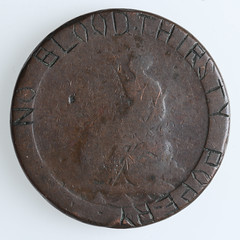 The earliest sentiments
expressed in the collection are anti-Catholic with ‘NO BLOODTHIRSTY POPERY' shown here struck on the reverse of a George III cartwheel penny. The movement against British rule
first appears on a penny of George V with the slogan ‘NO ENGLISH RULE' stamped on a 90 degree angle across the king's bust. These early examples remind us of the long ‘prehistory'
of the Troubles era. The major part of the collection consists of coins struck and defaced from the 1960s to the 1980s. A number of these reflect nationalist attitudes towards the
Republic with ‘BAN EIRE GOODS' (Figure 3) and ‘SEND PADDY HOME' stamped on Irish coins. A large number of coins bear slogans or acronyms relating to the principal paramilitary
groups of the period. The most prevalent are simple, crudely punched initials for the Irish Republican Army (IRA) (Figure 4), Ulster Volunteer Force (UVF), or Ulster Defence
Association (UDA). The likelihood is that these pieces were produced on an ad-hoc basis, perhaps by workers in their lunchbreaks. They passed into circulation as anonymous acts of
subversion, attachment to a cause, or designed to intimidate. In this sense they were a form of graffiti that could be circulated.
The earliest sentiments
expressed in the collection are anti-Catholic with ‘NO BLOODTHIRSTY POPERY' shown here struck on the reverse of a George III cartwheel penny. The movement against British rule
first appears on a penny of George V with the slogan ‘NO ENGLISH RULE' stamped on a 90 degree angle across the king's bust. These early examples remind us of the long ‘prehistory'
of the Troubles era. The major part of the collection consists of coins struck and defaced from the 1960s to the 1980s. A number of these reflect nationalist attitudes towards the
Republic with ‘BAN EIRE GOODS' (Figure 3) and ‘SEND PADDY HOME' stamped on Irish coins. A large number of coins bear slogans or acronyms relating to the principal paramilitary
groups of the period. The most prevalent are simple, crudely punched initials for the Irish Republican Army (IRA) (Figure 4), Ulster Volunteer Force (UVF), or Ulster Defence
Association (UDA). The likelihood is that these pieces were produced on an ad-hoc basis, perhaps by workers in their lunchbreaks. They passed into circulation as anonymous acts of
subversion, attachment to a cause, or designed to intimidate. In this sense they were a form of graffiti that could be circulated.
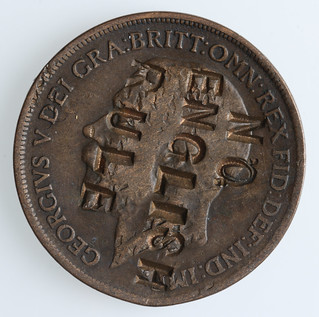
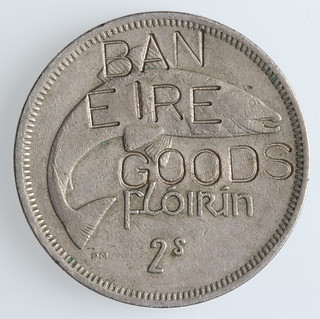
Figures 2 and 3
Figure 5 combines the UVF with the Ulster Freedom Fighters (UFF). In most cases, the nationalist or republican countermarks appear on United Kingdom coins, while the unionist or loyalist messages are stamped onto coins of the Republic of Ireland. Thus the attacks are directed towards the coinage and national symbols of the ‘other' side, the bust of Queen Elizabeth II in the case of the republican countermarks, and the symbols of the Irish Republic in the nationalist countermarks, usually the salmon on the two shillings and ten pence pieces.
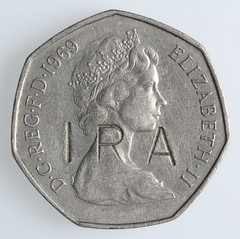
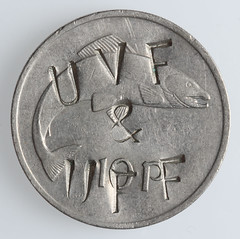
Figures 4 and 5
Other examples reference more specific themes. The one illustrated in Figure 6 is a 1971 UK two-pence which has been stamped with ‘SMASH H BLOCK 8' on the obverse bust. The H-blocks at the Maze/Long Kesh prison housed prisoners convicted of scheduled offences after 1 March 1976, with H-block 8 reserved for IRA prisoners. The hunger strikes of 1981 came in protest at the removal of Special Category Status from prisoners and led to the deaths of ten IRA hunger strikers. The strikes were a Pyrrhic victory for Margaret Thatcher and her government's hard-line approach to this miserable episode as it led to an increase in IRA recruitment and an upsurge in violence. The final coin illustrated as Figure 7 is an Irish 50 pence with the words ‘ULSTER IS BRITISH' stamped on the upper part of the reverse above the woodcock. This claim was a favourite trope of Ian Paisley during his fiery public addresses.
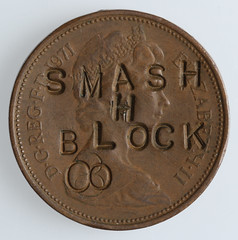
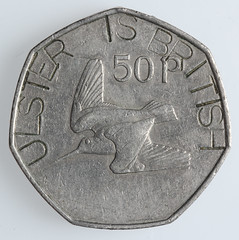
Figures 6 and 7
Material such as this is a poignant rejoinder to the claim that numismatics comprises generic and non-local material. The objects discussed above reveal how mundane, everyday objects were reworked into political touch-pieces. Rather than being generic and non-local these coins are a material reminder of a violent and contested past specific to Northern Ireland. If readers have seen any recent examples of defaced coins of this sort I'd be keen to hear about them at rmk34@cam.ac.uk

SEDWICK NOVEMBER 2019 SALE HIGHLIGHTS
The press release describes highlights from the November 1-2, 2019 auction by Daniel Frank Sedwick, LLC. -Editor
Gold bars, Honduras coin rarity to appear in Sedwick's November Treasure Auction
A large variety of gold and silver shipwreck bars as well as numismatic rarities will attract excited bidding during Daniel Frank Sedwick, LLC's Treasure, World, U.S Coin & Paper Money Auction 26. The floor auction will be held on Nov. 1-2, 2019 at the DoubleTree Disney Springs in Orlando, FL and live online.

Ingots from famous wrecks like the “Tumbaga wreck” of ca. 1528 will be found in the sale. The Atocha, sunk in 1622 off Key West, Florida, will be represented by three gold “finger” bars, one of which is a long specimen weighing 1,325 grams and estimated at $50,000 and up that last appeared in the 1987 Caesars Palace auction of Atocha artifacts. A further seven large silver ingots from the Atocha will also be sold, several of which have the same Caesar's Palace pedigree.
Shipwreck coins will also appear in the auction, many of which were held in collections for many years. The John Pullin collection of dated Mexican cobs is comprised of choice gold escudos and silver reales, most of which are pedigreed to the 1715 Plate Fleet, sunk off the east coast of Florida. The group includes an important gold 8 escudos dated 1714 and graded NGC MS 60 that was salvaged by the Real Eight Company and photographed in a 1965 National Geographic article that made the Fleet's coins famous. A similar assembly of coins, the Atocha Classics collection, will feature top-quality silver cobs from that popular wreck. Likewise, another two collections focusing on South American medals will cross the block. The Whittier collection of Bolivian Monetary Medals boasts high grade examples of circulating gold and silver commemoratives from the 1800s, all graded by PCGS. Following that, the Santander collection is composed of rare Colombian proclamation medals and includes a very rare “Gibraltar de America” trial strike (lot 1133) with a pedigree going back to Glendining's Peltzer sale in 1927.
The highest estimated coin in the sale is lot 942, a Honduras gold 20 pesos dated 1888 and graded NGC AU 58. Based on mint records and opinions from numismatists Henry Christensen and Holland Wallace, probably fewer than 30 examples were struck; only three are known to survive today. It is estimated at $40,000 and up.
Other top lots in the sale include:
- Lot 2: Mexico City, Mexico, cob 8 escudos, 1714J, "GRAT" variety (date on reverse), NGC MS 63, ex-1715 Fleet (designated on special label), ex-Real Eight, ex-John Pullin (stated on label). Estimate: $15,000 and up.
- Lot 4: Mexico City, Mexico, cob 8 escudos, 1715J, NGC MS 63, ex-1715 Fleet (designated on special label), ex-John Pullin (stated on label). Estimate: $12,500 to $20,000.
- Lot 28: Lima, Peru, cob 8 escudos, 1708H, NGC MS 63, ex-1715 Fleet (designated on label). Estimate: $15,000 and up.
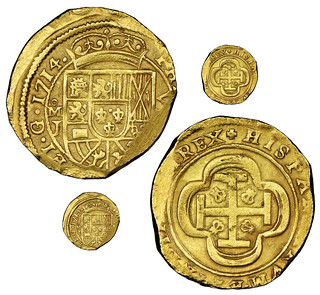 - Lot 32: Lima, Peru, cob 8
escudos, 1715M, rare, NGC XF 45, ex-Loosdrecht (1719). Estimate: $10,000 to $15,000.
- Lot 32: Lima, Peru, cob 8
escudos, 1715M, rare, NGC XF 45, ex-Loosdrecht (1719). Estimate: $10,000 to $15,000.
- Lot 85: Small gold disk, 373 grams, 18K, marked with 48, small double-slash and A/V monogram, ex-Luz (1752), ex-Sotheby's. Estimate: $17,500 and up.
- Lot 295: USA (New Orleans Mint), gold $2-1/2 Classic Head, 1839-O, NGC AU 55 / SS New York (1846), housed in promotional "book." Estimate: $5,000 to $7,500.
- Lot 298: USA (San Francisco Mint), gold $20 coronet Liberty "double eagle," 1865-S, PCGS AU58 / Brother Jonathan (1865). Estimate: $8,000 to $12,000.
- Lot 407: Mexico City, Mexico, cob 8 reales Royal (galano), 1715J, NGC XF details. Estimate: $15,000 and up.
- Lot 591: Argentina (River Plate Provinces), Potosi mint, 8 reales, 1813J, NGC MS 63+. Estimate: $2,500 to $3,750.
- Lot 1078: Lima, Peru, gold 8 escudos, 1841MB, extremely rare, NGC XF 45, Calico La Onza Plate Coin. Estimate: $10,000 and up.
- Lot 1097: Toledo, Spain, gold double excelente, Ferdinand-Isabel, T to left and cross of five dots flanking shield on reverse, NGC MS 63*, finest and only example in NGC census. Estimate: $7,000 to $10,000.
- Lot 1292: Bogota, Colombia, Banco Prendario, 1 peso, 1881, series A, serial 00855, PMG Choice UNC 64 EPQ. Estimate: $2,500 to $3,750.
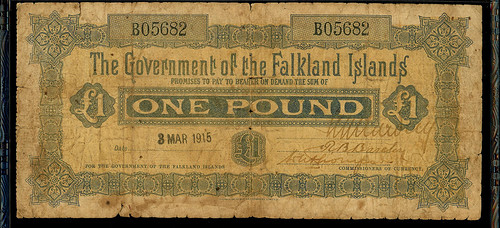
- Lot 1312: Falkland Islands, Government of the Falkland Islands, 1 pound, 3-3-1915, serial B05682, PMG Fine 12, rare. Estimate $4,000 and up.
- Lot 1317: Athens, Greece, Bank of Greece, 25 drachmai specimen, no date (1897-1900), PMG VF 30, rare, only known example in PMG census. Estimate: $2,500 and up.
Bidders can register now for the auction at www.auction.sedwickcoins.com; the catalog will be available online beginning Oct. 8. For more details, please contact Daniel Frank Sedwick, LLC at office@sedwickcoins.com.
STEPHEN ALBUM RARE COINS AUCTION 35 RESULTS
Here's a press release with results for the Stephen Album Rare Coins Auction 35. Some nice coins. Look for more in their upcoming January 2020 sale. -Editor
Stephen Album Rare Coins held its Auction 35 on September 12-14, 2019 at its offices in Santa Rosa, California. The auction greatly exceeded expectations, with a total realized price of $1.66 million (including buyer's fees) and a sell-through rate of 92.6%. The firm's COO Mike Barry remarked: “We were anticipating a strong sale, but we were happy to see strong bidding across the entire auction. We were both surprised and pleased with the prices and the excitement that bidders were showing for these lots”.
Three interesting collections helped to attract bidders to the sale. One major highlight from the collection of Dr. Axel Wahlstedt (chairman of the Swedish Numismatic Society from 1916-1934) was a zodiac ½ rupee, the first of its kind offered at public auction. It realized a price of $41,650. The Jerry D. Williams Collection of Elephant Coins was also a highlight, and part II will be offered in the firm's January 2020 auction. The first of three parts of The Christian Rasmussen Collection of Ilkhan coins also achieved very strong prices. Part II of that collection will be offered in the firm's January 2020 auction as well. Many items went for multiples of their estimates, including the following (prices include buyer's fees):
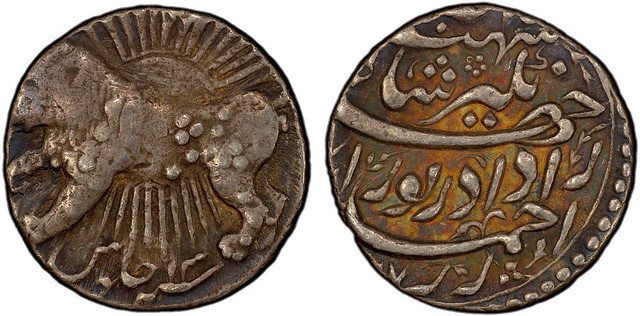
LOT 175: MUGHAL: Jahangir, 1605-1628, silver ½ rupee, Ahmadabad, AH1027 year 13, KM-138.2, zodiac type, Leo (lion left), with the sun rising behind, attractive original
tone, PCGS graded EF40, ex Dr. Axel Wahlstedt Collection.
Estimated Value: $10,000 to $15,000. Sold for $41,650.
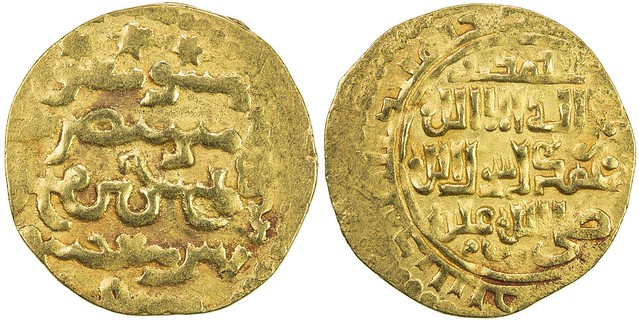
LOT 1367: ILKHAN: Ahmad Tekudar, 1282-1284, gold dinar (4.09g), Tabriz, DM, A-2138, standard design and calligraphy, as the previous Tabriz dinars of Abaqa and the later
Tabriz dinars of Arghun, Gaykhatu, and Baydu; with the king's name only in Uighur, VF, RRRR, ex Christian Rasmussen Collection.
Estimated Value: $9,000 - 11,000. Sold for $26,180.
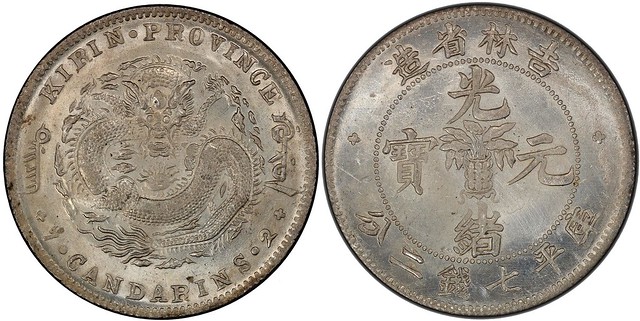
LOT 1749: KIRIN: Kuang Hsu, 1875-1908, silver dollar, ND (1898), Y-183, L&M-516, small scales on dragon variety, a choice example with superb luster, PCGS graded
MS62.
Estimated Value: $8,000 - 10,000. Sold for $22,610.
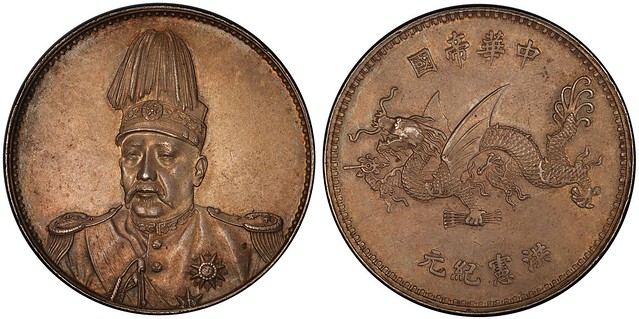
LOT 1707: CHINA: Hung Hsien, 1915-1916, silver dollar, ND [1916], Y-332, L&M-942, Kann-663, struck for the intended inauguration of Yüan Shih-kai as Emperor Hung
Hsien, facing bust of Yûan Shih-kai in military attire and tall, plumed hat // dragon flying left, lovely old toning, PCGS graded AU58.
Estimated Value: $5,000 - 6,000. Sold for $23,800.
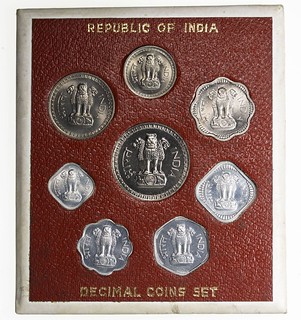 LOT 409: INDIA: Republic,
8-coin proof set, 1967(b), RB-14, official set includes 1, 2, 3, 5, 10, 25, 50 paise and 1 rupee; the rupee is dated 1962 and all others dated 1967, set in original package of
issue and of the utmost rariety for a modern Indian set, Proof, set of 8 coins.
LOT 409: INDIA: Republic,
8-coin proof set, 1967(b), RB-14, official set includes 1, 2, 3, 5, 10, 25, 50 paise and 1 rupee; the rupee is dated 1962 and all others dated 1967, set in original package of
issue and of the utmost rariety for a modern Indian set, Proof, set of 8 coins.
Estimated Value: $2,000 - 3,000. Sold for $7,735.
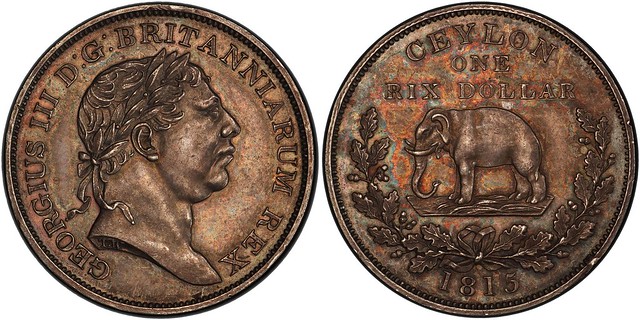
LOT 1926: CEYLON: George III, 1796-1820, silver rixdollar, 1815, KM-Pn7, Pridmore-81, pattern, Elephant within wreath, PCGS graded Proof 63, RR, ex Jerry D. Williams
Collection.
Estimated Value: $2,500 - 3,000. Sold for $7,735.
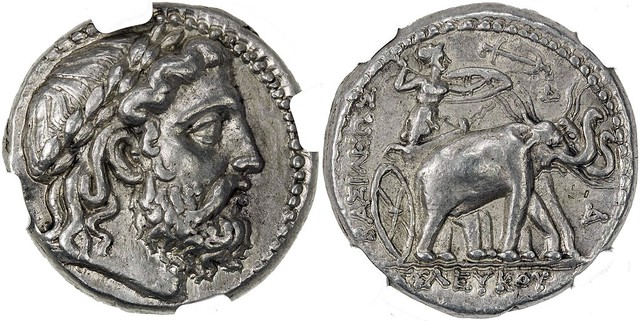
LOT 449: SELEUKID KINGDOM: Seleukos I Nikator, 312-281 BC, silver tetradrachm (17.20g), Seleukeia on the Tigris mint, SC-130 variety, head of Zeus right, wearing laurel
wreath // Athena, brandishing spear in right hand, monogram below, shield on left arm, in quadriga of elephants right; anchor and D above, strike 5/5, surface 5/5, NGC graded
Choice EF star , ex Jerry D. Williams Collection, ex Jonathan K. Kern.
Estimated Value: $900 - 1,100. Sold for $3,094.
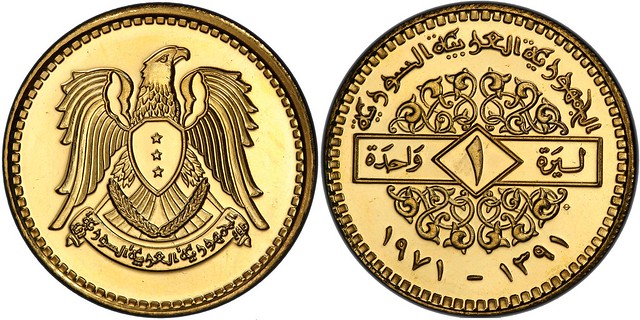
LOT 2195: SYRIA: Arab Republic, gold lira, 1971/AH1391, KM-98, Hawk of Quraish, trial strike in gold, PCGS graded Specimen 67, RRRR, ex Sherritt Mint Archives.
Estimated Value: $1,000 - 1,500. Sold for $11,305.
Company founder Stephen Album commented “All sessions of the auction were consistently strong, even the Numismatic Literature. We are happy with the results.”
The firm is currently taking consignments until November 1 for its Auction 36, which will be held January 23-25, 2020. Please visit www.stevealbum.com for more information.
To read the earlier E-Sylum article, see:
STEPHEN ALBUM RARE COINS AUCTION 35 (https://www.coinbooks.org/v22/esylum_v22n35a22.html)
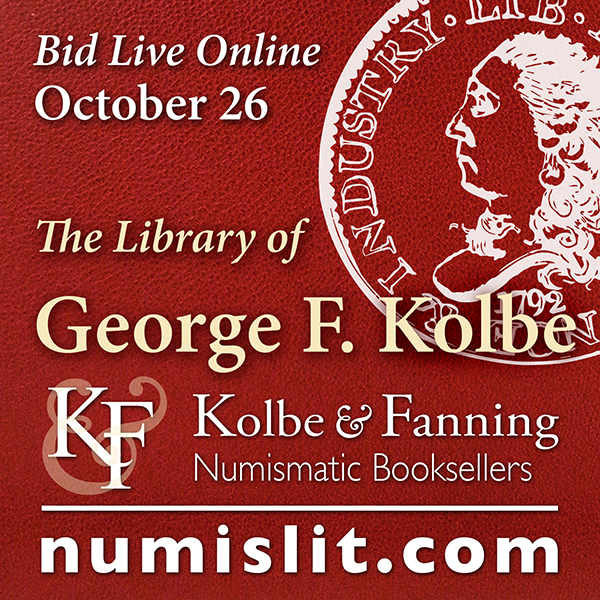
NUMISMATIC NUGGETS: OCTOBER 6, 2019
Here's a selection of interesting or unusual items I came across in the marketplace this week. Tell us what you think of some of these. -Editor
1796 Papal States 2 1/2 Baiocchi
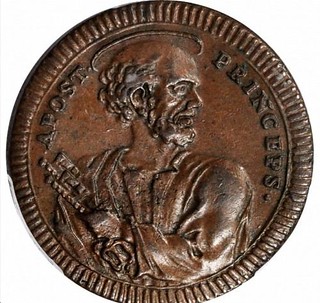
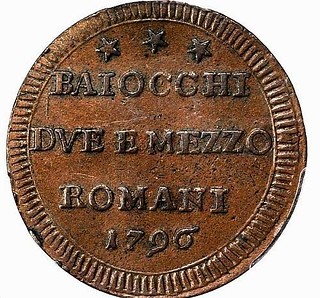
Country: Italy - Papal States
Year/Period and Variation: 2 1/2 Baiocchi, 1796.
Nr. of Items: 1 certificate
Condition: PCGS AU-50
Certified: PCGS
Papal States. 2 1/2 Baiocchi, 1796. PCGS AU-50
A coin of remarkable beauty.
An unusual pose for a subject - far more coins show just the subject's head (neck up) or a bust (shoulders up). Even fully standing or horse-riding subjects (shown head-to-toe) are more common in my experience than this torso (waist up) treatment. Has a book or monograph ever been written on this topic in numismatics (or art in general)? -Editor
To read the complete lot description, see:
Italy - Papal States - 2 1/2 Baiocchi, 1796. (https://auction.catawiki.com/kavels/29929407)
J. C. TILTON Counterstamp
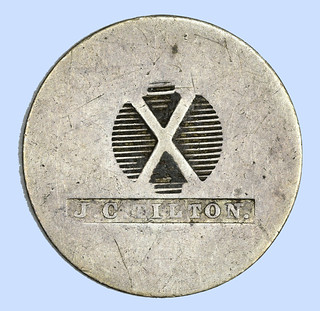
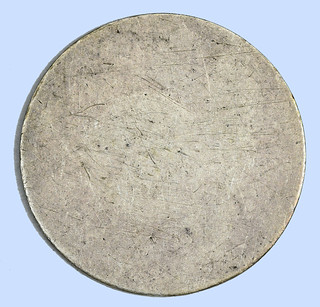
"X (in circle) / J. C. TILTON."
Worn U.S. Dime (?) or Planchet
Raised letters.
Appears to be a privately issue "dime" (ten cent piece).
More research is needed.
Brunk T-300.
This is one of Bob Merchant's current eBay listings. Unusual piece, but I like it! -Editor
To read the complete lot description, see:
Rare Enigmatic "Privately Issued Dime" Counterstamp
"X / J. C. TILTON." (https://www.ebay.com/itm/Rare-Enigmatic-Privately-Issued-Dime-Counterstamp-X-J-C-TILTON/133192659353)
1918 Japan Bando Lagergeld 1 Yen
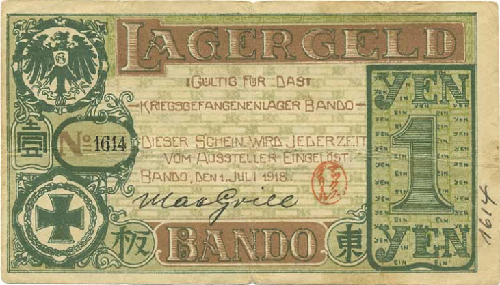
Interesting prisoner of war camp note. In WWI Japan was allied with Great Britain and they attacked and captured a German settlement on the east coast of China in August 1914, taking about 4,700 Germans prisoner. Ultimately nearly 6,000 German POWs were housed in the Bando camp.
Found via the October 1, 2019 issue of News & Notes published by the Society of Paper Money Collectors. -Editor
To read the complete article (in German), see:
Lagergeld im Bando-Lager – Wie Beethoven nach Japan kam
(https://www.geldscheine-online.com/post/lagergeld-im-band%C5%8D-lager-wie-beethoven-nach-japan-kam)
1941 Double-Struck Wheat Cent
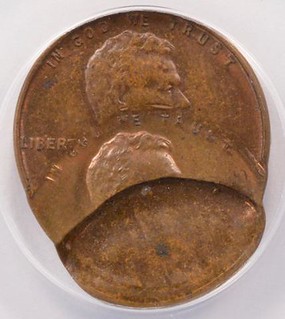
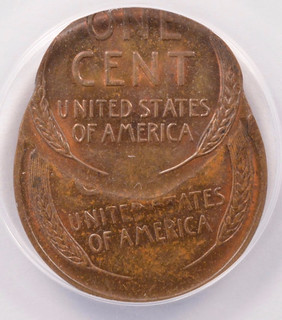
ANACS 1941 wheat cent double-struck with the 2nd strike 40% off-center and indent obverse. The date is visible under the 2nd strike. Dramatic and eye-catching double-strike, with lots of design visible on both strikes. Good eye-appeal, and scarce like this.
MS63 Red/Brown
I saw this fabulous error in the new purchase section of dealer Jon Sullivan's web site. -Editor
To read the complete lot description, see:
anacs 1c 1941 wheat cent double-struck 2nd strike 40% off-center
ms63 rb (https://sullivannumismatics.com/coin/anacs-1c-1941-wheat-cent-double-struck-2nd-strike-40-center-ms63-rb)
ESTONIAN VIKING-ERA SILVER COIN FIND
Found via The Explorator newsletter is this article from Estonia on a recent find of Viking-era silver coins. I liker the pictured coin - is that a hand? Is is a salute? A wave? -Editor
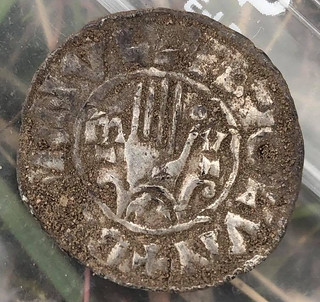 Another archaeological find has been made on
the island of Saaremaa, just weeks after a major haul including a 1,700-year-old gold bracelet came to light.
Another archaeological find has been made on
the island of Saaremaa, just weeks after a major haul including a 1,700-year-old gold bracelet came to light.
The recent find dates from a later era, the viking period, ERR's online news in Estonian reports, and includes a large number of silver coins, according to both the Heritage Protection Board (Muinsuskaitseamet) and Saaremaa Museum.
As with the earlier treasure trove, the latest find was the work of a metal detector hobbyist, who, in line with Estonian law, informed the authorities.
"We are grateful for the licensed hobby detector, who reported the findings to the Heritage Protection Board, which can now preserve some of the crucial history of Saaremaa," Saaremaa Museum stated on its social media page (see also gallery below).
Two separate hoards were found. One of these dating to the second half of the 10th century, contained silver coins which came via the Viking trade route which crossed the Baltic from the present-day Swedish island of Gotland, to Saaremaa's southern coast, and then on to Lääne County and on to present-day Tallinn.
To read the complete article, see:
Another Saaremaa archaeological haul includes viking-era silver
coins (https://news.err.ee/988737/another-saaremaa-archaeological-haul-includes-viking-era-silver-coins)
To subscribe to Explorator, send a blank email message to:
Explorator-subscribe@yahoogroups.com
DETECTORISTS ACCUSED OF STEALING COIN HOARD
The Telegraph this week reported on the trial of a group of metal detectorists accused of taking and not reporting an Anglo Saxon coin find. The image is a stock photo of coins of the era. -Editor
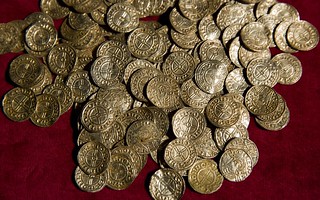 A group of metal detectorists stole Anglo
Saxon coins worth £3 million as well as "invaluable" ancient jewellery they found in a field before selling them on the black market, a court heard.
A group of metal detectorists stole Anglo
Saxon coins worth £3 million as well as "invaluable" ancient jewellery they found in a field before selling them on the black market, a court heard.
George Powell, 38, and Layton Davies, 51, are accused of failing to declare a priceless hoard of 1,000-year-old buried treasure they discovered on farmland in June 2015.
The pair along with Paul Wells, 60, and Simon Wicks, 57, went on trial on Thursday accused of conspiring to conceal the treasure at Worcester Crown Court.
Their valuable find was said to include a gold ring, bracelet and silver ingot from the ninth century, a crystal ball pendant from the fifth century and 300 coins, including some from the era of Alfred the Great.
Jurors were told all four were aware of the law which states buried treasure must be declared, but chose to ignore it and proceeded to sell the items in small batches to a number of customers.
Opening the prosecution's case, Kevin Hegarty QC said: "This case you are to hear in two words is about buried treasure.
"They decided to treat the find as theirs and not to declare it to the landowner, the tenant farmer and the coroner. In short, they stole it."
To read the complete article, see:
Metal detectorists accused of stealing £3m haul of Anglo Saxon
coins and jewellery after finding it in field (https://www.telegraph.co.uk/news/2019/10/03/metal-detectorists-accused-stealing-3m-haul-anglo-saxon-coins/)
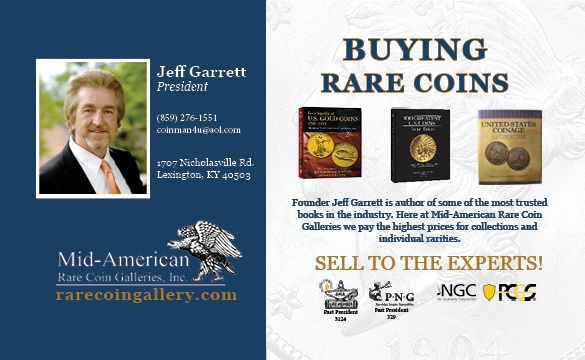
S.S. NORTH CAROLINA MAY HOLD DAHLONEGA COINS
Aaron Oppenheim passed along a FoxNews article about salvage efforts at the wreck of the S.S. North Carolina off the coast of South Carolina. I had seen a Charlotte Observer article about it earlier in the day. The Observer piece says the salvagers believe "Many of the passengers were likely carrying coins from the newly commissioned U.S. Mint in Dahlonega, Georgia..." -Editor
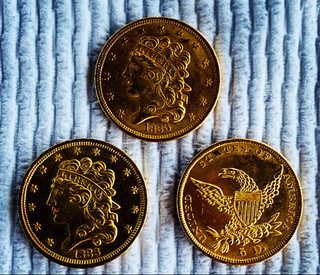 A 180-year-old shipwreck
popular with scuba divers is proving to be a trove of rare coins and artifacts for a salvage project launched 20 miles off the South Carolina coast.
A 180-year-old shipwreck
popular with scuba divers is proving to be a trove of rare coins and artifacts for a salvage project launched 20 miles off the South Carolina coast.
Known to divers as “The Copper Pot,” the wreck is actually the Steamship North Carolina, which collided with another boat in 1840 with hundreds of gold coins stuffed in passenger's steamer trunks.
The first of the newly found coins -- “several” $5 gold pieces dating from the mid-1830s -- were brought up in late September, along with 19th Century dinnerware and marble, according to Blue Water Ventures International based in Florida.
“I can't believe what we're finding,” Keith Webb, president of Blue Water Ventures, told McClatchy news group. “The coins look almost as if they were just minted and it's blowing our minds. It's because they were hidden by a large piece of copper and were not moved around in the sand by the current.”
The S.S. North Carolina was previously searched for treasure by an outfit called MAREX, which salvaged $700,000 worth of coins in the late 1990s. MAREX ceased working the site in part because the coins were difficult to salvage.
Recovery efforts will continue -- weather permitting -- into November, he says.
Time will tell exactly what coins are recovered. We'll stay tuned for more news. I reached out for comment to E-Sylum reader and contributor Bob Evans, who has worked on all of the salvage efforts from the wreck of the S.S. Central America. -Editor
Bob writes:
I am aware of the S.S. North Carolina, remembering it from MAREX's effort back 20-odd years ago. Shipwrecks are all different, with this shallow-water (humans can actually dive on it) never making it into my professional sphere. Very interesting however, and always neat to see the little numismatic wonders that are hidden in shipwrecks. Remarkable time capsules!
To read the complete articles, see:
19th-century shipwreck is suddenly turning up gold coins off South Carolina coast
(https://www.charlotteobserver.com/news/local/article235661717.html)
1840 shipwreck reveals trove of gold coins that could be worth million
(https://www.foxnews.com/science/1840-shipwreck-reveals-trove-of-gold-coins)
1813 BIRMINGHAM WORKHOUSE SIXPENCE
Sorry for the delay - we missed the sale date - but here's a press release from Dix Noonan Webb about a very rare token, the largest copper piece ever issued in Great Britain. -Editor
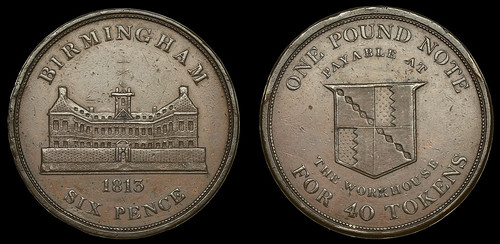
Dix Noonan Webb, the international coins, medals, banknotes and jewellery specialists are delighted to be selling the largest copper coin ever issued in Great Britain. It will be included in an auction of British Tokens on Thursday, October 3, 2019 at their auction rooms in central Mayfair - 16 Bolton St, London, W1J 8BQ. The extremely rare sixpence coin which weighs 163g (the weight of 46 of todays 1p) and measures 48mm in diameter, dates from 1813 and is estimated at £2,000-3,000.
As Christopher Webb, Director and Head of the Coin department, Dix, Noonan, Webb explained: “This coin was produced in Birmingham to be used in a workhouse, only 10 specimens are now known and this one is arguably the finest available to commerce. It is being sold as part of a group of 19th Century Tokens from the Collection from the Late Francis Cokayne, and will be sold with a related affidavit as to its 19th century provenance.”
He continues: “Believed to have been in circulation for a short time, the coins owe their probable existence to the temporary low price of copper relative to silver at the time. The last time this token was on the open market, at the second Norman sale in 1905, it brought £17 10s (the equivalent of £2,100 today), easily the top price in that auction.”
The affidavit, signed by Emery Davies, reads:
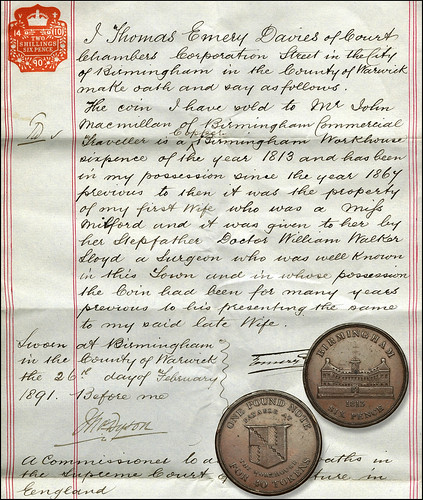 “I Thomas Emery Davies of Court
Chambers Corporation Street in the City of Birmingham in the County of Warwick make oath and say as follows: The coin I have sold to Mr John Macmillan of Birmingham Commercial
Traveller is a Copper Birmingham Workhouse sixpence of the year 1813 and has been in my possession since the year 1867 previous to then it was the property of my first wife who
was a Miss Milford and it was given to her by her stepfather Doctor William Walker Lloyd a surgeon who was well known in this Town and in whose possession the Coin had been for
many years previous to his presenting the same to my said late Wife”.
“I Thomas Emery Davies of Court
Chambers Corporation Street in the City of Birmingham in the County of Warwick make oath and say as follows: The coin I have sold to Mr John Macmillan of Birmingham Commercial
Traveller is a Copper Birmingham Workhouse sixpence of the year 1813 and has been in my possession since the year 1867 previous to then it was the property of my first wife who
was a Miss Milford and it was given to her by her stepfather Doctor William Walker Lloyd a surgeon who was well known in this Town and in whose possession the Coin had been for
many years previous to his presenting the same to my said late Wife”.
‘Sworn at Birmingham in the County of Warwick the 26th day of February 1891. Before me. Jno. Dyson, A Commissioner to administer oaths in the Supreme Court of Judicature in England.”
The token sold for £7,500. -Editor
To visit the Dix Noonan Webb website, see:
https://www.dnw.co.uk/
GOLD TELFORD MEDAL OFFERED
A blog article published October 3, 2019 by James McCartney of Stack's Bowers highlights an important historic medal offered in the firm's upcoming November sale. -Editor
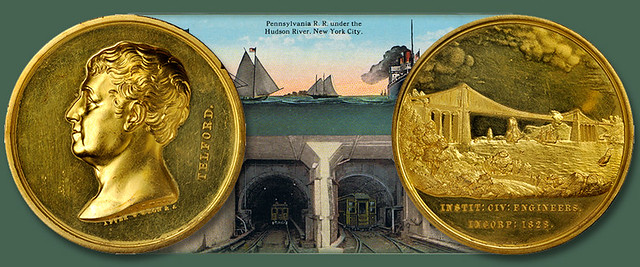
The Telford medal is the pinnacle of awards in the field of engineering and this particular example has strong ties to a major development in a major American city. We are delighted to be offering it in our November 2019 Baltimore Auction, where it will be accompanied by several significant gold medals.
It was first announced by the British Institution of Civil Engineers in 1835 following a bequest from Thomas Telford, who was the organization's first president. The award medal was intended to recognize innovation in the field of engineering and is open to engineers from all over the world. While the medal was first awarded in 1837, all of the medals are dated 1828 in exergue, marking the year the Institution received a royal charter from King George IV.
Initially, the medals were struck in gold, silver and bronze, and it is the silver and bronze versions that are most often encountered. However, it has been almost exclusively presented in gold since 1901. The gold examples are highly coveted and rarely come to market. We are aware of just one other specimen that has been offered publicly over the past decade.
The specimen to be presented in our November auction was awarded in 1910 to British engineer Charles Mattathias Jacobs for his construction of the North River Tunnels linking New Jersey and Manhattan beneath the Hudson River. These tunnels were commissioned by the Pennsylvania Railroad Company to establish for the first time uninterrupted rail service between Philadelphia and Manhattan. Chief Engineer Jacobs began working on the designs for the project in 1902 and started construction in 1904. Excavation of the bedrock began simultaneously on each side of the Hudson, with two teams working toward each other building tubes of iron and concrete beneath the river. When the first tubes were united in September 1906, they formed the longest underwater tunnel in the world. The North River Tunnels were officially opened in November 1910, shuttling trains between Weehawken, NJ and Pennsylvania Station in Manhattan.
Over a century later, these tunnels are still being used by today's commuters. They currently allow a maximum of 24 one-way train trips per hour, for a total of 48 trains between the two tunnels. Traffic reached a peak in the late 2000s, when over 430 trains were making the commute per day. The tunnels were flooded and extensively damaged by Hurricane Sandy in November 2012, and as a result, increased delays have frustrated commuters ever since. The tunnels are scheduled to be refurbished as part of the $20 billion Gateway Program that is planned to be completed in 2026.
This is an extremely impressive medal that marks an historic milestone in New York City history. Weighing nearly 4 troy ounces, it is struck in dramatic high-relief with considerable swirling die polish on the obverse bust of Thomas Telford. The surfaces show vibrant yellow gold coloration with honey shades around the truncation and apricot patina at the edges. The rims feature subtle engine-turning which produces a lovely rippled texture. Also included is the original leatherette case lined in purple velvet with an intact, functioning clasp. The case is lightly worn with a portion of delamination at the lower right edge.
As a fan of the history of business and technology, medals relating to engineering achievements are of special interest. Like many Americans, I've traveled those tunnels on multiple occasions, scarcely giving them a thought. An important achievement. -Editor
To read the complete article, see:
Historic Gold Telford Medal be Featured in our November 2019 Baltimore
Auction (https://www.stacksbowers.com/News/Pages/Blogs.aspx?ArticleID=Historic-Gold-Telford-Medal)
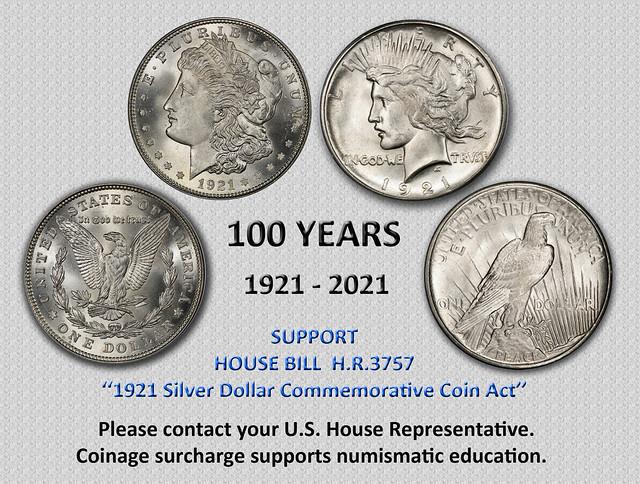
A FAMILY OF STRUCK FAKE LARGE CENTS
Jack Young published a nicely illustrated article on the CoinTalk site about a "family" of fake struck large cents all stemming from a single original master coin. Here's an excerpt - see the complete article online for full information. -Editor
After writing the previous “family” article about rather deceptive struck counterfeit half cents based on the genuine 1804 “C-6” variety (at coinweek.com ) I felt it timely to document another member of the family, the counterfeit large cents based on the 1833 “N-5's”.
Just a note, I consider this type of counterfeit an intermediate level of deceptive “types”, better than the lower level fakes from the ones I refer to as “Chinese Cartoon” types up to the multiple lower level “Ali” offerings.
These struck fakes are documented in several different denominations and varieties and are fairly accurate as compared to the source coins, but the counterfeiters use the same layout and change the date to create a series of fakes, resulting in impossible die combinations/ states. These take a higher level of knowledge to discern, with being savvy with the series and variety attributions part of the best defense.
I co-authored an article for EAC a couple of years ago about a suspicious 1816 large cent for sale on the internet. The following is the image that centered that discussion.
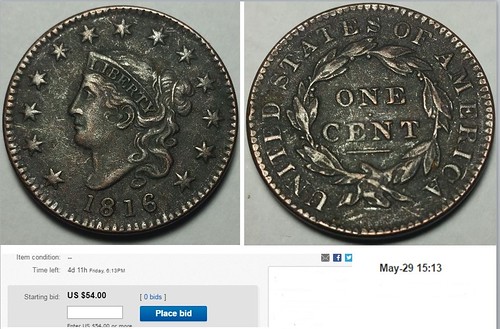
My collaborator than ran through all of the known varieties for 1816 large cents to prove it didn't match any of them!
This prompted additional discussion among EAC members with another adding the following- “once again, 1833 Newcomb 5, except for the date. de'ja vu all over again. this one even shows the rim ding above the D from the mother coin”.
“The mother coin was an 1833N5 with a rim ding over the D of UNITED. These are easy to spot once you know what was copied to make the dies. Most of these middle date counterfeits match the attribution points of the 33/5 including the die cracks of a MDS example. The most dangerous of the group is the 1833, it passes the die attribution test for N5 including the "horned 8" but the rim and edge is still wrong”.
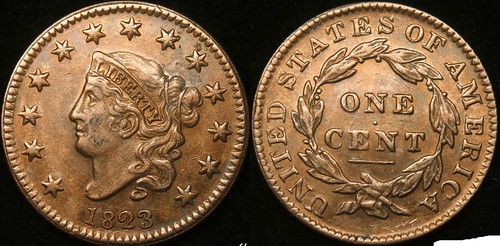
Counterfeit “1823” large cent

“1816” “1823” Genuine 1833 N-5 (courtesy PCGS)
I'll stop here, but see the rest of the article online for more. Thanks to Jack for his permission to republish this here. Some interesting and scary fakes out there. Use your numismatic noodle before bidding on these concoctions. -Editor
To read the complete article, see:
A “Family” of struck fake large Cents
(https://www.cointalk.com/threads/a-%E2%80%9Cfamily%E2%80%9D-of-struck-fake-large-cents.347824/)
AUSTRALIAN $20 HAS FEATURES FOR VISION-IMPAIRED
Australia has released a new banknote with features for the visually impaired. Quite colorful. -Editor
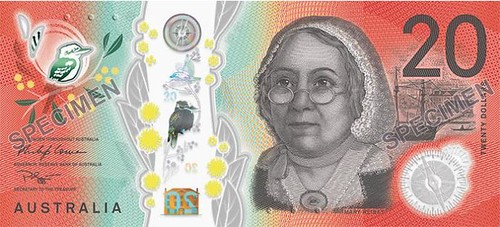
The Reserve Bank of Australia has unveiled the new $20 note, which has been specially manufactured to assist vision-impaired Aussies to use the currency.
Launching the note today at Vision Australia in Kooyong, the RBA said three raised bumps on each of the long edges of the banknote will allow people who have low vision or are blind to identify the note amongst other Australian currency.
Other features designed to assist the blind include millimetre-specific sizing compared to other denominations and holographic panels designed to catch light as the note is folded.
Chris Edwards, government relations manager at Vision Australia, said the new note will be most welcomed amongst those who currently struggle with the nation's banknotes.
"These tactile features enable the 350,000 Australians who are blind or have low vision to now accurately and easily identify the cash they are handling, like the rest of the community, and that's how it should be," said Mr Edwards.
"Without the tactile marking, many people who are blind or have low vision relied on a mobile phone app or a small device to measure the size of banknotes, which vary by a few millimetres. These solutions are fiddly, time consuming and impractical.
"We commend the RBA for responding to the needs of people who are blind or have low vision and demonstrating that accessibility is not something that should be put in the too hard basket."
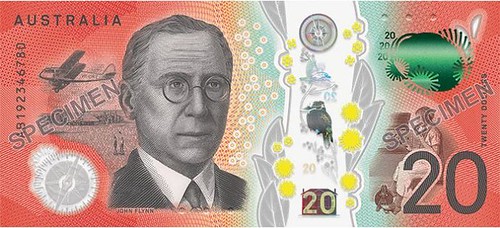
The famous faces on the note will remain the same as the previous edition: on one side is Mary Reibey, a female convict who broke social norms to become a businesswoman, and Reverend John Flynn, who started the world's first aerial medical service in 1928, which is now known as the Royal Flying Doctor Service.
As for fauna and flora, the new note features the Acacia Buxifolia (a species of native Australian wattle) and the Laughing Kookaburra (Dacelo novaeguineae).
To read the complete article, see:
New $20 note unveiled with special
features to assist vision-impaired Aussies
(https://www.9news.com.au/national/australia-rba-banknote-20-note-vision-impaired-release-date/3e496e9e-cb8c-459b-a485-3a3a939942b7)
PAPERBOY COLLECTING LESSONS
A column in The Record of Troy, NY publishes the coin-collecting memories of an old paperboy. -Editor
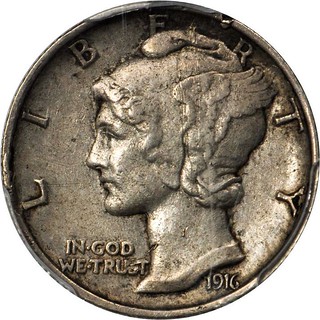 I don't play very often so I
wouldn't profess to being good at a game that takes endless hours to master. About a half hour into the tournament we were on the green and I marked the placement of the ball with
a small thin liberty head mercury dime. One of the people in my foursome picked it up, stared at it a moment and said, “Where did you get this old coin?”
I don't play very often so I
wouldn't profess to being good at a game that takes endless hours to master. About a half hour into the tournament we were on the green and I marked the placement of the ball with
a small thin liberty head mercury dime. One of the people in my foursome picked it up, stared at it a moment and said, “Where did you get this old coin?”
They were all shocked when I told them I received that coin from an old woman on Francis Street in South Troy around four o'clock one afternoon in 1975.
Right out of the gate you are wondering how I could be so precise about the coin and date. I'll admit I could be off on the year by some small margin but I'm certain of the senior citizen who gave it to me and where she lived. Back then I was a paperboy in Troy and on Friday nights I would do my collections. A weekly subscription to the Troy Record back then was about a buck and since there was no internet or Pay Pal or money apps to swipe a card, customers paid you in cash.
Most used modern currency but I had one older customer on my route who had jars and jars of old coins keeping watch on the shelves that lined her kitchen. Even though I showed up like clockwork every Friday looking for payment my arrival always seemed to surprise her. She'd answer my knock on the door with a, “Oh my, is it that time already? OK, young man just hold on a minute.”
She'd then go into her purse for cash but whenever she was short she'd pull down a jar and shake out some old coins.
More than once I said to her, “Ma'am, some of these coins (the liberty dimes and buffalo nickels) are worth more than a dime or nickel so why don't I stop back when you have current currency.” She'd wave me away and say, “Ah, a dime's a dime” and hand it to me.
I started saving the coins and today, 40 plus years later I still have them. I pulled a few of the dimes out years ago when I started playing golf, to use them as ball markers and they always seem to generate a conversation with my teammates.
One final thought. In the comedy golf movie “Tin Cup” I noticed Kevin Costner marked his ball by placing a liberty head dime on the turf. I'm guessing Kevin was a paper boy.
I began delivering newspapers in our Pittsburgh neighborhood at age 11. It was a great experience for a kid, and helped me along in my coin collecting hobby, as it did with many a paperboy. Those days are gone now, but I'm sure a number of our readers had a similar experience years ago. -Editor
To read the complete article, see:
Fade to Gray: Paperboy lessons
(https://www.troyrecord.com/news/local-news/fade-to-gray-paperboy-lessons/article_e480eb8a-e45e-11e9-aacf-2fc3c8c48cfc.html)
WORLD'S LARGEST NOBEL PRIZE MEDAL
The Art Daily newsletter for today (Sunday, October 6, 2019) had a gallery of photos from the Alfred Nobel Museum in Stockholm, Sweden. I love the museum door. -Editor
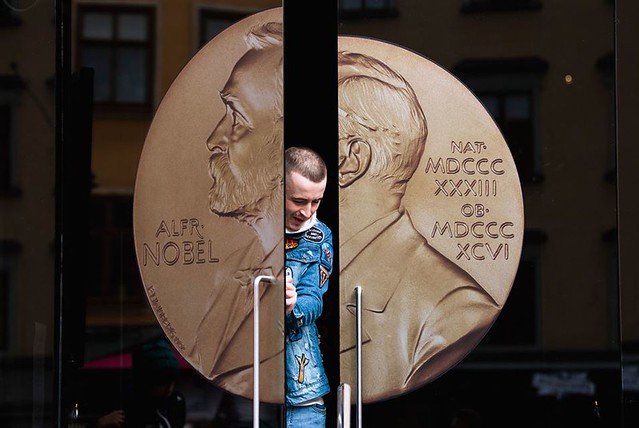
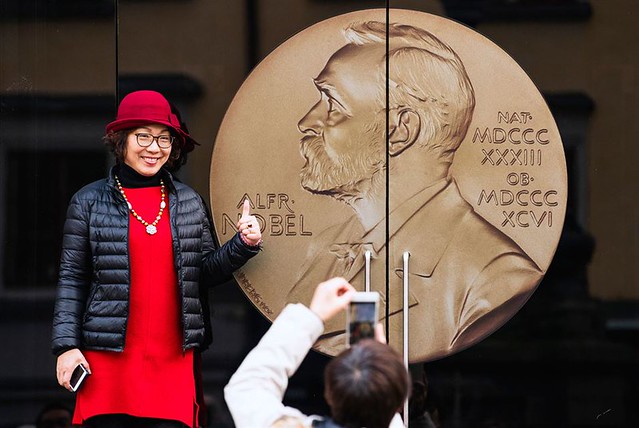
To read the complete article, see:
Sunday, October 6, 2019 : The Best Photos of the Day (http://artdaily.com/?date=10/06/2019&bfd=9)
FEATURED WEB PAGE: RENAISSANCE PORTRAIT MEDALS
This week's Featured Web Page is an online exhibit of Renaissance Portrait Medals from the Robert Lehman Collection at the Metropolitan Museum of Art in New York."The commemorative medal has its origins in 15th-century Italy. Several aspects of early Italian Renaissance culture led almost inexorably to the rise of the medal: the humanist emphasis on the primacy of the individual, the revival of classical antiquity, and the related desire to perpetuate personal fame and achieve earthly immortality in emulation of the great persons of the ancient world.
"The medal succeeded in memorializing many men and women who might otherwise have disappeared from the historical stage. These small disks of metal, wood, or stone communicate a wealth of information about their portrait subjects, either explicitly or in the obscure language of symbol, allegory, and emblem. Through text and image, the medal celebrates an individual's unique qualities, power, accomplishments, family status, dynastic links, aspirations, beliefs, and significant life events (such as birth, marriage, and death).
"The most successful portrait medals also convey the artist's skill in composing complex and balanced designs within the confines of a tiny circle, through the use of elegant lettering, sensitive portraiture, subtle modeling of forms and textures, and rich narratives. At its best, the medal embodies quintessential Renaissance values: purity of style, harmony, dignity, balance, and the gravitas regarded as an important foundation of character."
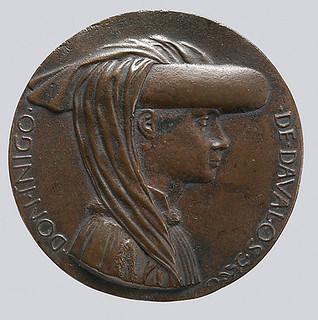
https://www.metmuseum.org/exhibitions/listings/
2016/renaissance-portrait-medals/exhibition-themes

